#its lightweight and compact design
Explore tagged Tumblr posts
Text

#Chicago Bulls#Stay hydrated while out on adventures#at the gym#at work#or anywhere your day takes you. The Oregon sport bottle is a custom sports bottle with 13.5 fl.oz capacity that is available in 12 colors t#its lightweight and compact design#it makes the perfect outdoorsy companion.
0 notes
Text

INFO - LIST FOR TRANSABLED AID ACCESS
A list of discreet access of assistive aids , ways to hide assistive aids , and euphoria inducing replacements .
Where to get assistive aids ?
01 , An obvious choice would be online shopping , although discreet shopping can be a bit difficult . Buying many things at once so you get a big / couple of packages could be a way to not turn any eyes , especially now that the holidays are coming up . " But I live with people who have the tendency of opening my packages " , there are a couple of options of what you can do - use a p.o box or locker service ( ex: amazon locker will send you an email with pickup instructions ) , choosing a specific delivery time of when you are only home / you have time to be the first one to pick it up ( tip : have delivery notifications on so you can be the first one to receive it ) , have delivery instructions to specify where to put the package ( ex : behind a pot plant , under the steps , etc ) , have it delivered to your friends / work . " But big shopping sites aren't safe for me " , Facebook Marketplace and Craigslist could be a better option for you , may be also safer as you can request the person selling you the item to make it discreet / can also be on the cheaper end , as they tend to be used . It can also be safer on the end of simply picking it up , making it so that there isn't any sort of electronic transaction that can be seen on a bank / phone receipt . 02 , Thrifted / Yard sales are also a good option - not only is it generally more discreet , allowing you to take it home by simply putting it in your bag without any other notice , but it's also generally cheaper , seeing that often times its used items still in a somewhat good condition . " What / where do I look for ? " , I would often suggest Goodwill , as they tend to have a wider range of mobility aids . You can also find them at your local small shops - try calling ahead and asking if they have anything , as they mostly will have more time to look through their storage . " How do I know it's worth it ? " , shopping out is a greater option as you can test out if the aid is good for you . When shopping for aids , test if they are sturdy , if they are the right size for you / there is any ability to diy fix it to your measurements , and how you would be able to put it away / hide it .
When it comes to what sort of aid is the most discreet : Canes : foldable canes are the most discreet , they are compact and are able to be carried in a bag . Double use canes , such as umbrella canes , are also discreet in the sense of being able to play it off as just an umbrella . Rollator : also good to consider a foldable rollators / walkers , ones that also have a seat can be passed off as just portable seats . Wheelchairs : Wheelchairs , unless you live in a spacious area without any judging eyes , are hard to turn discreet . While folding wheelchairs are a thing , plus lightweight ones - like most wheelchairs , they are expensive , and often are badly fitted / uncomfortable . ++ temporary replacements are a better option . Hearing Aids : Hearing Aids kept in their case can very easily be passed out as to be wireless earbuds / there are many hearing aids that resemble simple ear buds. Although , Hearing Aids bought online aren't the most reliable , and may be even dangerous - so temporary / thrifted replacement is a better option .
Where do I hide my aids if I am in an unsafe environment ?
While hiding things from the people you live with can be draining , it is still suggested for your safety .
01 , Folding Aids - Any aid that is able to be neatly folded and easily stored is the best when it comes to hiding . Placing them in bags in also the best , as you are able to take them out once you leave your place . Another way would be having a designated spot outside your place , where you can easily access it once you are out . More ways of hiding them : in drawers , unused umbrella holders , under your mattress , in coat hoodies , old shoe boxes .
02 , Aids with Wheels - While trickier , definitely able . The biggest suggestion is to have folding versions . You can fold them and store in the back of your closet along the wall . You can put it on the frame of your bed and put a mattress over it . If you have a rug , putting it specifically near / under your bed , and then the aid right under the rub can also be an option . If you have a dresser , sliding it between the wall and the dresser's side can help . On top of closets can also be good . When needing to store it for outside use , big portfolios could fit them . 03 , Hearing Aids - Probably the easiest to hide as they resemble ear buds . Although getting custom / decorated cases can be good for disguising them . Nonetheless , if needed , hiding them in small pockets of backpacks , coat pockets , pencil cases can be extra security . " What if I immediately need to hide something for my safety ? " , when opening your drawer - look past the drawer / take it out , you will see that there is room on the inside of the frame , even with the drawers fully closed . You can throw any smaller sized aid in that space , and then simply take out the drawers to take it back when ready . Another way for more bigger aids - take out all of the drawers from a dresser , put the aid inside , then put the drawers back in . If the back of your dresser is a softer material that's able to be cut , cut a ⊏ shape so that it creates a flap , put your aid in and tape the flap , put your dresser back up on the wall - the flap is an easier access than taking out all drawers . Although if you feel like you are in immediate danger for having an assistive aid in your home , prioritize your safety and take the aid out of your home . You are worth more than something that you will be 100% able to get back in the future < 3
DIY - ING
Everyone should be able to have access to assistive aids - even when it comes to creating their own .
Folding Crutches . ( need to already have simple crutches ) Cane out of yardsticks . ++ easier , You can make a cane by taking hard pvc pipe , sealing the bottom + adding a stopper ( shaped rubber or foam ) , while at the top you cut out to sides of a handle - a top and bottom , glue it with hot glue and attach it.

While it may not be as sturdy - it's still a good alternative .
More affordable assistive aid shopping :
essentailaids.com , affordable canes / crutches / walkers - lots of accessories , has wheelchairs too .
mobilityshop.co.uk , also affordable AND a huge range , so you have some options . Also offers accessories and some more simpler accessibility aids .
argos.co.uk , on the more pricier end yet still quite affordable , also offers joints support and braces .
abilitysuperstore.com , while not as affordable as other sites , still has a pretty decent price range - but has way more options to offer .

#.ᐟ my dear corpse ..#transid#transabled#transid transitioning#transid transition tips#transid transition#transid transitioning tips#rq 🌈🍓#rqc🌈🍓#pro radq#pro radqueer#rq#radqueer#pro rq 🌈🍓#radqueer safe#pro transx#rq community#radq interact#rq safe#rq 🍓🌈#rqc#rqc 🍓🌈#pro rqc#rq coining#radq safe#radq coining#radqueer community#rqc 🌈🍓#rq interact#rq please interact
187 notes
·
View notes
Text
Reliable Power Solutions: Honda Generator
In today’s fast-paced world, having a dependable power source is essential. Whether you're working on a project, camping outdoors, or facing a power outage, the Honda generator is here to ensure you never run out of electricity. Designed for versatility, efficiency, and portability, Honda generators are a trusted companion for countless situations.
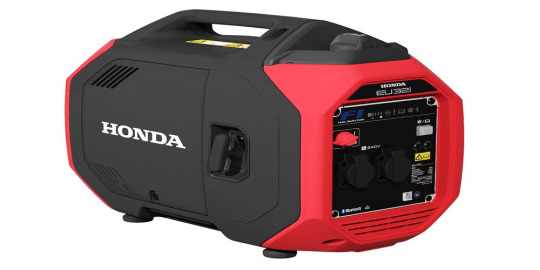
Why Choose a Honda Generator?
Honda is renowned for its engineering excellence, and their generators are no exception. With superior build quality and innovative features, these devices are built to last. Here’s why the Honda generator stands out:
Durable Performance: Equipped with high-quality engines, Honda generators deliver consistent power output, ensuring your devices run smoothly.
Fuel Efficiency: Honda’s advanced engineering ensures maximum power with minimum fuel consumption.
Portability: With compact designs and lightweight models, Honda generators are easy to transport.
Eco-Friendly: These generators are designed to meet stringent emission standards, making them environmentally responsible choices.
Popular Uses of Honda Generators
Outdoor Adventures: Camping, tailgating, or RV trips are made easier with a portable power supply.
Home Backup Power: Ensure your essential appliances keep running during unexpected outages.
Worksites: From power tools to lighting, Honda generators are perfect for construction sites.
Tips for Maintaining Your Honda Generator
Regularly clean and inspect the generator.
Use high-quality fuel and oil.
Check the air filter and spark plug periodically.
Store the generator in a dry, safe place when not in use.
Disclaimer:
Always follow the manufacturer’s guidelines for operating and maintaining your generator. Use responsibly to avoid damage or accidents.
109 notes
·
View notes
Text

1970 Plymouth Duster vs. 1973 Dodge Charger
1. **Engine Options**: The 1970 Plymouth Duster offered engines ranging from a 198 cu in (3.2 L) Slant-6 to a 340 cu in (5.6 L) V8, while the 1973 Dodge Charger had engine choices from a 318 cu in (5.2 L) V8 to a 440 cu in (7.2 L) V8.
2. **Performance**: The Duster, particularly with the 340 V8, was known for its lightweight body and agile performance, whereas the Charger, being larger and heavier, delivered more power but with a focus on a balanced ride.
3. **Design**: The Duster featured a compact, sporty design with a fastback roofline, while the Charger had a more substantial, muscular design with a distinct Coke bottle shape and long hood.
4. **Interior**: The Duster's interior was simpler and more utilitarian, reflecting its economy car roots, while the Charger's interior offered more space, comfort, and luxury features.
5. **Market Position**: The Duster was positioned as an affordable, compact muscle car aimed at younger buyers and budget-conscious enthusiasts, whereas the Charger targeted a more upscale market, blending performance with style and comfort.
6. **Transmission**: Both cars offered a range of transmissions, but the Duster typically came with a 3-speed manual as standard, with optional 4-speed manual or 3-speed automatic, while the Charger often featured a standard 3-speed automatic, with a 4-speed manual as an option.
7. **Price**: The Plymouth Duster was generally more affordable, making it a popular choice for those seeking performance on a budget, while the Dodge Charger, with its larger size and added features, came at a higher price point.
#Plymouth Duster#dodge charger#car#cars#muscle car#american muscle#mopar#moparperformance#moparnation#moparworld#dodge#plymouth#charger#duster
89 notes
·
View notes
Text
Control Collar
The control collar used by Enforcer Conscripts is a compact, high-tech device designed for subduing and controlling attackers or resisting individuals. It represents a blend of advanced engineering and practical enforcement needs, tailored to the dystopian setting of the Republic. Here’s a detailed description based on the context:

Design
Appearance:
The collar is sleek and predominantly matte black with metallic accents. Its design reflects the austere, utilitarian aesthetic of the Security Forces.
It has a segmented structure that allows it to expand and contract to fit around different neck sizes.
Material:
Made from a durable, lightweight alloy combined with flexible polymers. It is resistant to physical damage and tampering.
The inner lining is padded with a material that ensures a secure grip but minimizes discomfort to avoid unnecessary harm.
Size:
Compact when folded, roughly the size of a fist. It unfolds into a circular collar that can be applied quickly.
Markings:
Engraved with a small alphanumeric code for inventory and tracking.
Displays a faint glow when activated, usually in blue or red, depending on the mode.

Functionality
Application:
Designed to be deployed quickly in high-pressure situations. It uses a spring-loaded mechanism that snaps securely into place around the neck.
Enforcer suits often feature a compartment for easy storage and access to the collars.
Control Interface:
Operated wirelessly through the Enforcer’s HUD or a wrist-mounted device. Controls include activation, intensity adjustment, and deactivation.
Includes fail-safes to prevent unauthorized use or accidental activation.
Features:
Electrostimulation: Can emit controlled electrical pulses to immobilize the wearer temporarily. The intensity can be adjusted to suit the situation.
Vocal Disruption: Capable of emitting frequencies that suppress vocal cords, preventing the individual from shouting or calling for help.
Tracking: Equipped with a GPS and biometric sensors to monitor the wearer’s location and vital signs.
Tamper Detection: Alerts the operator if tampering is detected. Tampering triggers a warning pulse.
Safety Measures:
Automatically deactivates if it detects critical health parameters, such as a risk of cardiac arrest or asphyxiation.
Features a quick-release mechanism in emergencies, controlled by the Enforcer or a command override.
50 notes
·
View notes
Note
haiii what about natsuki with an s/o who’s also really good at making suits/weapons?? :00 hope ur doing ok!
Precision & Protection
(Natsuki Seba x Skilled Weapons/Armor Designer! Reader)
I'm doing good, thankyou!! I hope you're doing okay too!!<3
Natsuki Seba was used to working with precision. Whether it was dismantling an opponent’s weapon mid-fight or calculating the exact trajectory for a perfect shot, his hands never wavered. That same sharpness extended to his personal gear—his weapons, his suit, everything had to be just right.
Which is why he never let just anyone modify his equipment.
And yet, here he was, sitting in your workshop, watching as you adjusted the stitching on a reinforced tactical suit you had custom-made for him.
“You’re staring.” You didn’t look up from your work, fingers expertly threading the needle through specialized fabric that could withstand both gunfire and blades.
Natsuki scoffed and crossed his arms, leaning against the workbench. “I always check for flaws.”
You smirked, tightening the last stitch. “That’s funny. I don’t recall you finding any flaws in my last design.”
“…That’s because there weren’t any,” he muttered, looking away.
That was as close to a compliment as you were going to get from him.
You set the suit down, stretching before grabbing another project from the table—his gun. “By the way, I made some adjustments to this. You were complaining about the weight distribution, so I tweaked the balance. Try it.”
He caught the gun as you tossed it to him, immediately running through the motions. His fingers traced over the modifications, subtle but effective. The grip fit better in his palm, and the weight was perfect.
“…Not bad,” he admitted, clicking the safety on and off as he examined it.
You grinned, leaning in slightly. “You mean perfect.”
Natsuki’s ears turned slightly red, but he refused to acknowledge it. Instead, he set the gun down and picked up the suit. “I’ll test this later. If it slows me down, you’re fixing it.”
“Please, my work doesn’t slow people down—it keeps them alive.” You nudged him with your elbow. “And you keep people alive too. I’d rather not have my favorite guy getting stabbed because of subpar gear.”
His fingers tightened slightly around the fabric. You were always so casual about things like that—like you weren’t worried about him coming back from missions in one piece. But he knew better. He knew you put everything into your work because you did care.
“…Thanks,” he said quietly.
You blinked. “What was that?”
He clicked his tongue. “Don’t make me repeat it.”
You laughed, rolling your eyes. “Fine, fine. But hey—” You reached under the workbench, pulling out something wrapped in cloth. “—I made you something else.”
Natsuki raised an eyebrow as you handed it to him. Carefully, he unwrapped the package to reveal a sleek, foldable knife—one custom-made to fit his fighting style. Lightweight, razor-sharp, with a quick-release mechanism that was nearly silent.
“…This is—”
“Made just for you,” you said, watching his reaction closely. “I know you like to keep things efficient, so I figured you’d like something more compact.”
Natsuki flipped the knife open, testing its balance. The blade gleamed under the workshop lights, and when he moved, it felt like an extension of his own hand. It was flawless.
“…It’s perfect.”
Your grin widened. “Told you so.”
For once, Natsuki didn’t argue. He just pocketed the knife, grabbed the suit, and turned to leave—pausing briefly by the door.
“…Dinner later?” he asked, voice a little stiff but sincere.
Your eyebrows shot up. “You’re asking me out?”
He clicked his tongue. “Forget it—”
You laughed, grabbing his wrist before he could storm off. “I’d love to.”
He huffed, looking away, but you didn’t miss the small, satisfied smirk on his lips.
Yeah. You made the best gear.
But more importantly, you always had his back.
35 notes
·
View notes
Text
Kintaro 'Restoration's Sword'

(note: the above image shows Kamea's Kintaro prior to the November 3024 refit detailed below)
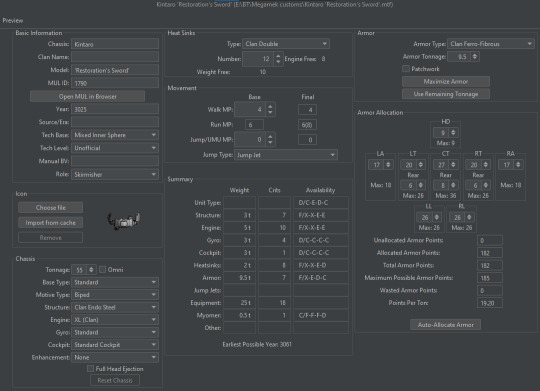
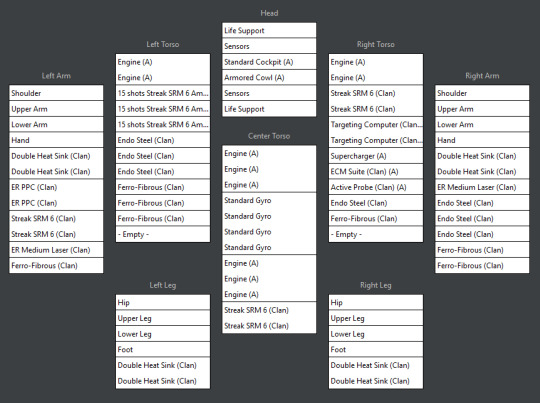
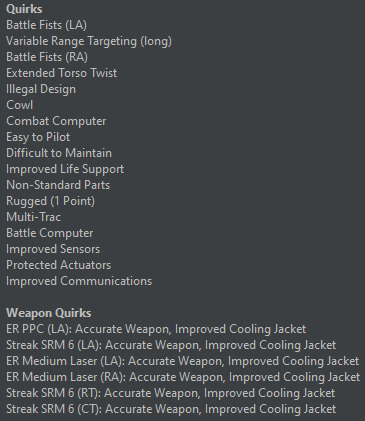
Overview:
Introduced in 2587 for the SLDF, the Kintaro was designed with one sole mission: tagging enemy units with a Narc Missile Beacon. As such, it is a 'Mech that is intended to work in a team with a missile-heavy lance. Put into production during the Third Succession War for the Federated Suns by General Dynamics of Ozawa, the downgraded KTO-18 Kintaro was manufactured using the Succession Wars era technology available at the time.
Capabilities:
This personalized one-off Kintaro variant was specially produced for High Lady Kamea Arano of the Aurigan Coaltion by Xerxes Truscott of the Fursona's Fusilier's mercenary company. The refit saw a complete tear down and rebuild of Kamea's original KTO-18 with (at the time) completely unknown technology.
While heavily modified from the original design, after its refit the 'Mech possessed much the same weapons loadout as before - save for the LRM launcher having been removed and replaced with a PPC of a range and energy output never seen in the Inner Sphere. Indeed, the 'Mechs pair of medium lasers had their maximum range increased by nearly seventy percent, while putting out nearly the same power as a large laser. In addition, the SRM 6 racks were replaced with significantly lighter models that exhibited a curious behavior - they did not fire until the tracking system achieved a positive lock with every missile in the salvo. All the non-missile weapons were assisted by a compact targeting computer (loaded with variable targeting software) in addition to custom accuracy and heat dissipation tuning done on each individual weapon.
CASE technology was somehow integrated into the newly added 9.5 tons of ferro-fibrous armor that protected a custom endo steel chassis. Meanwhile, numerous components were heavily armored, including the cockpit, which had a large amount of additional armor protection installed. An advanced XL engine of a smaller class than the original was added along with a supercharger. While the 'Mech did run 5 tons overweight (primarily due to the decision to up-armor the new engine), the combination of the supercharger and lighter chassis and armor ensured that the 'Mech's top speed and general performance was unaffected. Twelve advanced, compact double sinks replaced the original single models, and ensured that the Kintaro's infamous overheating issues were entirely solved.
Finally, the 'Mech boasted advanced, lightweight electronic countermeasures and active probe systems, seemingly based on the lostech Guardian and Beagle systems of the old Star League. Additional communications, sensor, and targeting improvements were also made to the 'Mechs software suite. The 'Mechs hands were reinforced for potential close quarters encounters, the actuators of the 'Mech given additional protection for urban fighting, and its torso rotation range was increased. An advanced life support system with numerous backups was added, customizable controls allowed Kamea to personalize the layout of the cockpit, and the use of smaller and lighter components increased available space inside the cockpit, rivaling a Thunderbolt or Atlas - this increased space was complimented by luxurious pilot comfort systems, all fit and finished for a noble. Finally, the B-2000 battle computer from a damaged Restoration Army Cyclops was installed, to allow Kamea to coordinate large scale operations from her pilot seat.
Deployment:
Kamea's Kintaro, dubbed 'Restoration's Sword', would deploy on numerous operations during the Aurigan Civil War, before and after its refit. It was present and fought at Kamea's hands to escape the Aurigan Directorate coup in 3022, and Kamea continued to train with it while in hiding. After its refit in November of 3024, it took up arms on Weldry in December, and continued in her service thereafter.
After the refit, the 'Mech was classified top secret, and no one outside of Argo mechbay staff and a bare handful of extremely well-veted royal household technicians were allowed to work on the 'Mech, and questions about the new technologies were brushed off by claiming the technology was recovered from a derelict Star League JumpShip, or later that it was retrieved from Castle Nautilus.
While these explanations served to mollify many, most intelligence organizations such as MIM, the Maskirovka, DMI and even ComStar were never fooled, even if they could not gain direct access to the 'Mech itself. It would not be until almost exactly a quarter century after the Aurigan Civil War ended that the wider Inner Sphere would learn the true origin of the many of the 'Mech's advanced technologies.
History:
While Kamea famously switched to a customized (and somewhat more mundane) Atlas II in the later stages of the Aurigan Civil War, she retained 'Restoration's Sword' in her personal motorpool, under heavy guard in all non-combat circumstances. The 'Mech would continue to serve the Aurigan Royal Guard even into the 32nd century, where it was often seen at the hands of 'The Mastiff' - the unofficial rotating title granted to the current chief bodyguard of the ruler of the Coalition.
Kintaro 'Restoration's Sword'
Mass: 55 tons Chassis: Technicron-Argo-1 Endo Steel Power Plant: Argo Custom 220 XL Cruising Speed: 43.2 kph Maximum Speed: 86.4 kph Jump Jets: None Jump Capacity: 0 meters Armor: Argo Advanced Ferro-Fibrous Armament: 2 ER Medium Laser 1 ER PPC 3 Streak SRM 6 Manufacturer: General Dynamics (original) / Fursona's Fusiliers (Refit) Primary Factory: Ozawa (original) / Argo Mechbay (Refit) Communication System: Tacticon B-2000 Battle Computer with Argo Advanced ECM Targeting & Tracking System: Starbeam 3000 w/ Argo Advanced Targeting Computer and Argo Advanced Active Probe Introduction Year: 3025 Tech Rating/Availability: F/X-X-F-X Cost: 16,774,823 C-bills
Type: Kintaro Technology Base: Mixed (Advanced) Tonnage: 55 Battle Value: 2,582
Equipment Mass Internal Structure Endo Steel 3 Engine (Armored) 220 XL 5 Walking MP: 4 Running MP: 6(8) Jumping MP: 0 Double Heat Sink 12 [24+4] 2 Gyro 3 Cockpit (Armored) 3 Armor Factor (Ferro) 182 9.5 Internal Armor Structure Value Head 3 9 Center Torso 18 27 Center Torso (rear) 8 R/L Torso 13 20 R/L Torso (rear) 6 R/L Arm 9 17 R/L Leg 13 26
Right Arm Actuators: Shoulder, Upper Arm, Lower Arm, Hand Left Arm Actuators: Shoulder, Upper Arm, Lower Arm, Hand
Weapons and Ammo Location Critical Heat Tonnage Double Heat Sink LL 2 - 1.0 Streak SRM 6 CT 2 4 3.0 Supercharger (Armored) RT 1 - 0.5 Streak SRM 6 RT 2 4 3.0 Targeting Computer (Armored) RT 2 - 2.0 Active Probe (Armored) RT 1 - 1.0 ECM Suite (Armored) RT 1 - 1.0 ER Medium Laser LA 1 5 1.0 Streak SRM 6 LA 2 4 3.0 Double Heat Sink LA 2 - 1.0 ER PPC LA 2 15 6.0 2 CASE LT 0 - 0.0 Streak SRM 6 Ammo (45) LT 3 - 3.0 Double Heat Sink RL 2 - 1.0 Armored Cowl (Armored) HD 1 - 1.0 ER Medium Laser RA 1 5 1.0 Double Heat Sink RA 2 - 1.0
Features the following design quirks: Accurate Weapon (all), Battle Computer, Battle Fists, Combat Computer, Cowl, Easy to Pilot, Extended Torso Twist, Improved Communications, Improved Life Support, Improved Cooling Jacket (all), Improved Sensors, Multi-Trac, Protected Actuators, Rugged (1 Point), Variable Range Targeting, Difficult to Maintain, Illegal Design (Mixed Tech Design Prior to 3050; Overweight), Non-Standard Parts
7 notes
·
View notes
Text
The Legendary Black Cat
Selena de la Rosa, known across Marley as the Legendary Black Cat, is the world's deadliest assassin—a master of agility, precision, and deception. When Marley turns against her, she is shipped to Paradis as a living weapon, chained and drugged, with her survival all but assured to be short-lived. But Selena is no ordinary prisoner.
Bound by no one, loyal to none, Selena plots her next move, determined to seize her freedom by any means necessary. Yet, her plans are complicated by the Scouts who captured her, particularly Captain Levi Ackerman—the so-called Humanity's Strongest Soldier. Selena is intrigued by his strength and reputation, but her pride refuses to acknowledge him as her equal.
Caught between Levi’s unrelenting gaze, Selena plays a dangerous game of manipulation. She’s biding her time, but when the moment comes, will her calculated escape bring her freedom—or will her path collide violently with Levi’s unwavering resolve?
The Black Cat has always landed on her feet, but for the first time, she might meet her match. (Levi x OC)

Chapter Forty One
The hangar at Scou headquarters was a cavern of controlled chaos, its high stone ceiling echoing with the clank of metal and the low hum of machinery. The air was thick with the scent of oil, leather, and anticipation, the flickering lanterns casting long shadows across the polished floor.
The Special Ops Squad stood in a tight circle, their new black stealth uniforms sleek and form-fitting, designed for silence and shadow. The fabric was lightweight but durable, hugging their bodies like a second skin, the dark matte finish absorbing the light to render them nearly invisible in the dark. Each uniform was equipped with modified ODM gear, its canisters and cables painted black to blend seamlessly, the blades sharpened to a lethal edge. Holsters at their hips held compact pistols, a last resort; Selena had insisted remain silent unless absolutely necessary.
Selena stood at the center, her presence a blend of fierce confidence and quiet warmth, her eyes scanning her squad with a mix of pride and protectiveness. Her black curls, which had grown past her shoulders in recent weeks, were now cropped back to neck length, a practical choice she’d made last night with a quick slice of her knife, the shorter style framing her face with a sharp, no-nonsense edge. The stealth uniform clung to her curves, accentuating her athletic build, the ODM gear strapped securely to her back, its cables coiled like a predator’s muscles. Hidden beneath the fabric were her signature knives—blades strapped to her thighs, wrists, and ankles, each one a deadly extension of her assassin’s craft. A black mask dangled from her belt, its design simple but effective, covering everything but the eyes, ready to be donned at the drop zone.
Levi stood beside her, his own uniform a mirror of hers, the black fabric emphasizing his lean, compact frame, his gray eyes sharp and unyielding. His ODM gear was meticulously adjusted, his blades gleaming, a pistol holstered at his hip. His dark hair was neatly combed, his expression stoic, but his gaze softened when it lingered on Selena, a silent acknowledgment of their shared resolve and love.
The squad was a study in contrasts, their nerves and determination etched into their young faces. Eren’s green eyes burned with intensity, his hands flexing as he adjusted his gear, his resolve to strike Marley unwavering. Mikasa’s dark eyes were calm but focused, her uniform fitting her like armor, her blades ready, her near-mastery of the 100 Cuts of Pain a quiet source of confidence. Armin’s analytical mind already mapping their route, his fingers twitching as he double-checked his gear. Jean’s jaw was tight, his skepticism tempered by trust in Selena and Levi, his pistol holster secure. Connie’s grin was subdued, his energy channeled into checking his ODM cables, while Sasha, her, patted her holster, her sharpshooter’s instincts sharp despite her nervous fidgeting.
Hange bustled nearby, her glasses glinting as she inspected the airship—a sleek, camouflaged beast with a dark hull and muted engines, designed for stealth. Its surface was painted in mottled grays and blacks, blending with the night sky, its propellers whispering rather than roaring. Commander Erwin stood at the airship’s ramp, his tall frame imposing in his own black uniform, his blue eyes scanning the squad with a commander’s scrutiny, his presence a steady anchor for the mission ahead.
Selena clapped her hands, drawing the squad’s attention, her voice clear and commanding despite the weight of the moment. “Alright, my precious amateurs,” she said, her tone warm but firm, a faint smile tugging at her lips. “We’re a few hours out from Liberio. Let’s run this down one last time. We board the airship, reach Marley in three hours, and drop at 23:55 over the port. There’s a guard change at midnight, which gives us a window to land unnoticed. We use ODM gear to hit the drop site, set up our rendezvous point, and move to the military base. The top brass—Calvi and his officers—meet at midnight in the underground bunker. We have five minutes to infiltrate, kill, and get out. No mistakes.”
Eren nodded, his voice steady despite the tension in his shoulders. “Five minutes to take out the head of Marley’s military. We can do this, Selena. You’ve trained us for it.” His faith in her was palpable, his fists clenching with determination.
Mikasa’s voice was calm, her hand resting on her blades. “We’ll follow your lead, Selena.” Her words were a quiet vow, her trust in her mentor absolute.
Armin adjusted his mask, his voice thoughtful. “The port’s layout is open, but the base has narrow corridors. We’ll need to stay tight, move as a unit. Selena, you’ve got the guard rotations—any changes we should anticipate?” His blue eyes sharp.
Selena’s lips quirked, her pride in Armin’s foresight evident. “Good question, Armin. The rotations haven’t changed in years—Marley’s too arrogant to think anyone would hit them like this. But if they’ve tightened security, we’ll adapt. You’re our strategist; keep those gears turning.” She gestured to Sasha. “Sasha, you’re our eyes from a distance. If we need a distraction, your aim’s our ace.”
Sasha grinned, patting her pistol. “Got it. I’ll keep the noise down with my bow and arrow, but if I have to use my gun, I’ll do it.” Her nerves were evident, but her resolve held.
Jean crossed his arms, his voice cautious but resolute. “Five minutes is tight, but we’ve drilled this. In and out, no heroics. Right, Connie?” He glanced at his friend, seeking reassurance.
Connie nodded, his grin returning, though it was tighter than usual. “Yeah, man. We’re stealthy now, thanks to Selena. Like shadows, right?” He adjusted his mask, his energy a buoy for the group, his trust in their training unshaken.
Levi’s voice cut through, low and sharp, his gray eyes sweeping the squad. “You’ve faced titans, survived worse than this. Stick to the plan, listen to Selena, and don’t fuck up.” His tone was harsh, but his faith in them was clear, his presence a steady anchor. He gestured to the small pouches at their belts, each containing Hange’s compact bombs. “After the brass are down, we plant these. Hange’s toys will level the base. Marley won’t know what hit them.”
Hange popped her head out of the airship’s cockpit, her grin wide. “Oh, my babies are gonna make a mess! Timed charges, remote detonation, enough to turn that bunker into rubble. You just plant them, and I’ll handle the boom!” Her enthusiasm was infectious, easing the squad’s tension, her hands already itching to pilot the airship.
Erwin stepped forward, his voice calm but commanding, his blue eyes intense. “This mission is Paradis’s first strike against Marley. You’re not just soldiers—you’re the blade that cuts their heart out. Selena’s expertise, Levi’s leadership, and your training make this possible. Cripple their command, and we buy time to end this war. I’ll be on the airship with Hange, ready to extract you. Trust each other, and come back alive.”
Selena nodded, her gaze sweeping the squad, her voice softening, a rare vulnerability breaking through. “One more thing,” she said, her hands tightening at her sides. “I told you before, and I’m saying it again—prioritize your lives. If this goes south, get out. Levi and I will handle the rest. I want you kids back in one piece. Promise me.”
Eren’s voice was fierce, his fists clenched. “Selena, we’re not leaving you to clean up our mess. We’re doing this together, and we’re all coming back.” Mikasa nodded, her voice soft but resolute. “You’ve taught us to survive. We won’t let you down.”
Armin’s eyes shimmered, his voice steady. “We’ll be careful, Selena, but we’re not abandoning you. We’re a team.” Jean’s skepticism softened, his voice firm. “Yeah, no way we’re letting you and the Captain hog the fight. We’ve got your back.” Connie grinned, his energy infectious. “Family sticks together, Selena. We’re not dying today.” Sasha, her eyes glistening, nodded. “We’ll make you proud, Selena. Promise.”
Levi’s gaze softened, a flicker of warmth in his eyes as he watched the squad rally, their bond a quiet strength. “Tch,” he muttered, his voice low. “Bunch of brats making promises. Just don’t make me drag your asses out of there.” His hand brushed Selena’s, a subtle gesture of reassurance, his trust in her and the squad unwavering.
Selena’s lips curved into a shaky smile, her heart swelling. “You kids,” she said, her voice thick. “I’m already proud.” She turned to Hange and Erwin, her resolve returning. “Let’s move. Time to board.”
The squad filed onto the airship, their boots echoing on the metal ramp, their black uniforms blending with the dark hull. The interior was cramped but functional, with benches along the walls, a small armory of spare blades and gas canisters, and a cockpit where Hange settled, her hands flying over the controls. Erwin took a seat near the ramp, his presence a silent command, his eyes scanning the squad with a mix of pride and resolve. The airship’s engines hummed to life, a low, muted thrum that vibrated through the floor, the stealth design ensuring near-silence as they prepared for takeoff.
Selena and Levi stood at the center of the cabin, the squad gathered around, their masks dangling from their belts, their faces a mix of nerves and determination. Selena unrolled a small map of Liberio, pinning it to a crate, her finger tracing the drop site. “We use ODM gear to hit the rendezvous point—a warehouse rooftop, here.” She tapped the map, her eyes meeting each squad member’s. “From there, we move to the base, infiltrate the bunker, and take out the brass. Plant the bombs, get out, and latch onto the airship. Five minutes, in and out. Questions?”
Armin raised a hand, his voice cautious. “If the guard change is delayed, do we adjust the drop time?” His mind was already running scenarios, his strategic instincts sharp.
Selena nodded, her respect for him evident. “Good catch. If the change is delayed, we circle once and drop at 01:05. Hange will signal us. But I doubt it’ll happen”
Jean leaned forward, his voice low. “What about the titan shifters? Zeke, Pieck, Porco—they’re in Liberio. If they show up…” His concern was valid, his eyes flicking to Levi, seeking reassurance.
Levi’s voice was clipped, his gaze hard. “If they show, we’re already gone. Stealth is the priority. Selena’s plan keeps us out of their reach.” His hand rested on his blades, his readiness a silent promise, his faith in Selena’s expertise unwavering.
Eren’s voice was fierce, his eyes blazing. “We’re not just hitting the brass—we’re sending a message. Marley’s not untouchable. We can do this.” His passion was infectious, bolstering the squad’s resolve, his trust in Selena and Levi a quiet fire.
Selena’s smile was fierce, her hand resting on the map. “Damn right, Eren. We’re the blade they’ll never see coming. You’re ready for this—my assassins, not just soldiers.” Her words were a rallying cry, her pride in them a steady flame, her faith in Levi a rock she leaned on.
As the squad dispersed to their seats, checking gear and masks, Levi pulled Selena aside, his hand on her arm, his touch firm but gentle. They stepped into a quiet corner of the cabin, the hum of the airship a low backdrop, the squad’s chatter fading. His gray eyes searched hers, a flicker of concern breaking through his stoic facade. “Selena,” he said, his voice low, rough with emotion. “Don’t be reckless out there. I know you—you’ll throw yourself into the fire to protect those kids. Promise me you’ll come back.”
Selena’s heart tightened, her hand covering his, her fingers lacing with his. “Levi…” she said, her voice soft, her eyes shimmering with love. “I’m not reckless, not with you watching my back. I promise I’ll come back—to you, to them. But you promise me the same, Capitán. No heroics either.” Her smile was teasing, but her grip was firm, their shared vow a quiet strength.
Levi’s smirk was faint, his hand squeezing hers, his voice a low murmur. “Tch. Deal, stray cat. Together, always.” He leaned in, his forehead brushing hers, a brief, stolen moment of closeness before the mission consumed them.
Selena nodded, her resolve hardening, her hand lingering on his before she stepped back, her voice steady. “Let’s do this.”
The cabin was quiet now, the squad’s nerves tempered by their training, their black uniforms a promise of the shadows they’d become. Selena stood at the map, her eyes tracing the route, her faith in her amateurs and her Capitán a fire that burned bright. The clock ticked down, one hour to Liberio, the mission a heartbeat away, their resolve unyielding as they soared toward their destiny.
…
Hours later, the airship sliced through the night sky, its camouflaged hull a shadow against the starless expanse, its muted engines a low hum that barely disturbed the clouds below. Inside, the Special Operations Squad sat in tense silence, their black stealth uniforms blending with the dim interior, their faces set with a mix of resolve and nerves.
The airship shuddered slightly as it reached the drop site, the port of Liberio visible through the clouds below, its docks a faint outline in the moonlight. Hange’s voice crackled through the cabin, her tone uncharacteristically focused. “We’re over the target. 11:54 p.m. One minute to drop. Masks on, people!” The squad moved as one, pulling their black masks over their faces, the fabric covering everything but their eyes, transforming them into specters of the night. Selena’s mask framed her green eyes, her gaze sharpening, the Black Cat ready to strike. Levi’s mask accentuated his piercing stare, his presence a quiet storm beside her.
Erwin rose, his tall frame commanding attention, his voice steady but resonant. “Scouts, this is our moment. Marley believes they’re untouchable, but tonight, you prove them wrong. You’re not just soldiers—you’re the blade that cuts their heart out. Selena’s expertise, Levi’s leadership, and your training make this possible. In five minutes, you’ll cripple their command, and Paradis will stand taller for it. Trust each other, move as one, and come back alive. We’re counting on you.” His eyes swept the squad, a rare warmth breaking through his stoicism, his faith in them a palpable force.
Eren nodded, his eyes blazing through his mask. “We’ll make them pay, Commander. For everything.” Mikasa’s voice was soft but firm. “We won’t fail.” Armin adjusted his gear, his voice steady. “Five minutes. We can do this.” Jean, Connie, and Sasha exchanged determined glances, their nerves tempered by their bond.
Selena’s hand brushed Levi’s, a silent vow, her voice low but fierce. “Let’s do this, amateurs. For Paradis.” Levi’s nod was curt, his eyes locked on hers, his trust absolute. The ramp hissed open, revealing the cloud-strewn night, the wind howling as the airship hovered high above Liberio. The squad lined up, their ODM gear ready, their hearts pounding but their resolve unyielding.
“Go!” Hange shouted, and they jumped, plummeting through the clouds, the cold air biting their exposed eyes. Selena led the descent, her body angled like a diving hawk, her ODM gear humming as she steered toward the docks, the port’s outline sharpening below. Levi followed, his form precise, the squad trailing in a tight formation, their black uniforms blending with the night. The clouds parted, revealing the sprawling docks, wooden piers, moored ships, and the faint glow of lanterns marking guard posts.
Selena’s eyes locked on the landing point, a shadowed warehouse rooftop near the port’s edge, its flat surface perfect for their rendezvous. She fired her ODM anchors, the cables snapping into the roof’s edge, her body swinging gracefully to land in a crouch, her blades drawn. Levi landed beside her, his movements fluid, his watch already out, the five-minute countdown ticking: 23:55. The squad followed, their landings silent but swift. They drew their blades, their eyes scanning the darkness, their masks hiding their fear.
Levi’s voice was a low hiss, his watch glinting. “Five minutes. Move.” Selena took point, her hand signals sharp and clear, guiding the squad toward the military base, a hulking structure of stone and steel just beyond the docks. The port was quiet, the guard change imminent, but every shadow held danger. They moved like ghosts, their boots silent on the cobblestones, their ODM gear coiled for action.
A dockworker appeared, his lantern swinging, his mouth opening to shout. Selena’s knife flew, embedding in his throat, his body collapsing before a sound escaped. Mikasa neutralized another, her blade slicing silently, her movements a mirror of Selena’s training. Eren and Connie dispatched a third, their blades swift, their faces grim. They didn’t think, didn’t hesitate—each kill was a necessity, the threat of an alarm a death sentence. Selena’s heart ached for their innocence, but her resolve held; they were assassins now.
The base loomed, its iron doors a barrier to their target. Selena signaled a halt, her eyes scanning the entrance, her hand testing the lock—bolted tight. “Shit,” she muttered, her voice muffled by the mask. “No keys.” Eren and Mikasa dropped to a nearby guard’s body, their hands searching his pockets, but found nothing, their movements frantic as seconds ticked by.
Sasha, perched on a crate, spotted movement—a guard rounding the corner, his mouth opening to yell. Her bow was in hand before anyone could blink, her arrow flying with deadly precision, piercing his throat. He choked, blood gurgling as he collapsed, his body twitching in the dirt. “Got him,” Sasha whispered, her voice steady, her sharpshooter’s instincts flawless.
Levi checked his watch, his voice sharp. “One minute thirty gone. We’re out of time.” His frustration boiled over, his foot slamming into the door—once, twice, five times—until the lock shattered, the metal screeching as it gave way. The noise was a thunderclap in the silence, and shouts echoed from within, boots pounding as Marleyan soldiers rushed toward the breach.
“Ambush!” Selena hissed, her ODM gear firing, her body swinging into action. The squad moved like a well-oiled machine, their training kicking in. Levi’s blades flashed, carving through a soldier’s chest, blood spraying as he spun to the next. Selena used her ODM cables as a weapon, mimicking Levi’s technique, her anchors latching into a soldier’s torso, yanking him forward as her blade slit his throat. She pivoted, using his body as a shield, absorbing a flurry of shots from another before dispatching him with a knife to the heart.
Eren’s ferocity was unleashed, his blades a blur as he cut down two soldiers, his roar muffled by his mask. Mikasa shredded a trio, her movements a deadly dance, blood pooling at her feet. Armin’s precision was surgical, his blades targeting vital points, while Jean and Connie fought back-to-back, their teamwork seamless. Sasha’s arrows flew, each one a silent kill, her bow a whisper in the chaos. The Marleyans, trained but unprepared, fell like wheat before a scythe, their screams cut short by the squad’s ruthless efficiency.
The bloodbath cleared a path to the stairwell, the stronghold’s entrance below. Selena nodded at Armin, their pre-planned tactic ready. He pulled a compact bomb from his pouch and hurled it down the stairwell. The explosion was a muffled roar, the screams of soldiers below echoing as shrapnel tore through them. The squad fired their ODM gear, diving into the smoke-filled stairwell, their blades finishing the wounded—quick, silent kills, their masks hiding their grimaces.
Levi checked his watch, his voice urgent. “Two minutes left. Move!” They landed in a corridor, the stronghold’s meeting room just ahead, its reinforced door a final barrier. But a wounded soldier, hidden in the shadows, raised his pistol, the gunshot deafening in the confined space. Jean cried out, collapsing as blood poured from his leg, the bullet lodged deep.
“Jean!” Connie shouted, his voice cracking, but Mikasa was faster, her blade silencing the shooter, his body slumping. The alarm blared, a piercing wail that echoed through the base, lights flashing red, the entire facility now alert. Selena’s heart sank, her worst fear realized—their stealth was blown, the titan shifters and reinforcements likely en route.
“Fuck!” Selena cursed, her voice sharp, her mind racing. They were so close, the meeting room within reach, Calvi and the brass behind that door. Retreat was logical, but abandoning the mission now meant failure, a chance lost forever. Her eyes met Levi’s, his gaze hard but resolute, his trust in her unwavering. “Take Jean and get to the rendezvous point—now!” she ordered, her voice brooking no argument. “Board the airship and get out!”
Eren’s eyes widened, his voice fierce. “Selena, we’re not leaving you!” Mikasa’s hand tightened on her blades, her voice steady. “We finish this together.” Armin’s face paled, his voice urgent. “We can still—”
“Retreat, now!” Levi roared, his voice a whip, his gray eyes blazing through his mask. “That’s an order! Move!” His authority was absolute, his fear for the squad’s safety overriding their protests. Connie hoisted Jean onto his back, the wounded soldier groaning, blood dripping onto the floor. Mikasa, Eren, Armin, and Sasha formed a protective barrier, their ODM gear firing as they ascended the stairwell, their figures vanishing into the smoke, their reluctance palpable but their obedience unwavering.
Selena and Levi turned to the meeting room’s door, the alarm’s wail a relentless pulse, the base alive with the clamor of approaching soldiers. Levi’s watch showed one minute thirty seconds left, the odds stacked against them. Selena’s heart pounded, her knives in hand, her resolve a fire that burned through her fear. “Levi,” she said, her voice low, her eyes meeting his through their masks. “This is it. We might not make it, but Calvi’s in there. We end this, or we die trying.”
Levi’s hand brushed hers, a fleeting touch, his voice rough but steady. “I’m not letting you die, Selena,” he said, his eyes fierce, his love for her a vow etched in steel. “We do this together. No one’s touching you while I’m here.” His resolve mirrored hers, his determination to see her survive a force as unyielding as his blades. He stepped back, his stance shifting, his foot poised to strike the door.
Selena nodded, her green eyes blazing, her body coiled for action, the Black Cat ready to strike. “Together,” she said, her voice a quiet vow, her trust in him absolute. Levi’s foot slammed into the door, the metal groaning as it buckled, the sound a thunderclap in the chaos. They exchanged a final glance, their bond a lifeline in the storm, and as the door gave way, they surged forward, blades drawn, ready to face their fate.
~
Masterlist | Patreon
Join my Taglist
Note: I am four chapters ahead on patreon :)
Tags: @Thirstyb-ches @spaghetticarbs @demonslayeranimex @levkuna @jinsfavoritedoll @escapingjune @mwezieclipze
#aot#aot x reader#attack on titan#eren yeager#levi ackerman#levi aot#shingeki no kyojin#aot smut#aot fanfiction#levi ackerman x you#captain levi#levi x reader#aot levi#snk levi#levi smut#levi attack on titan#levi fanart#eren aot#aot fanart#aot x black reader#aot x black y/n#levi x black reader#levi x black oc#levi x you#levi x oc
8 notes
·
View notes
Text
Updated: June 17, 2025
Rebel Army Machines
The Type-2 Armoured Fighting Vehicle “Di-Cokka” is well-known for being used in tough fights and its stationary H-Cannon, a short-barreled 155mm cannon capable of rapid fire. The original German-American variant featured two slow-firing turrets, but Rebel Army engineers redesigned the Type-2 Di-Cokka to be more compact, equipped with a single smoothbore gun capable of firing at high velocities. Rumours suggest that the H-Cannon had to remain stationary due to its heavy weight, but only the original engineers know the true reason. Due to its cost-effective production, the Rebel Army has been able to mass-produce the Type-2 Di-Cokka, making it the most produced tank in the army. Notably, even under limited conditions, the Rebels successfully created the tank's main gun without compromising its high quality, making it ideal for mass production.
The Type-3 Armoured Fighting Vehicle "Bull Chan" was developed by Rebel Army tacticians in response to concerns that the Regular Army could launch attacks from rugged terrain. Designed to counter this threat, the Bull Chan is a heavy tank featuring reinforced armour that's tough and durable. It's equipped with tracks that can easily traverse challenging terrain and climb steep hills due to its high ground clearance and wide tracks. Primarily used to launch attacks from high vantage points such as hilltops and mountains, these tanks excel at ambushing enemies in mountainous terrain.
Due to their vulnerability to aerial attacks, Rebel Army engineers reinforced the top armour and applied camouflage to blend in with the surroundings, disguising the tank as a large boulder. While this camouflage offers limited concealment from nearby ground troops, it effectively prevents detection by Regular Army spy satellites and reconnaissance aircraft. Notably, the Rebel Army views these tanks as highly expendable, frequently deploying them in large quantities without hesitation.
The Type-4 AFV “Girida-O” was the Rebel Army's response to the need for a main battle tank with a balanced mission profile, combining firepower, mobility, and survivability. Aware that the Regular Army was developing a superior vehicle, the SV-001, the Rebel Army sought to create a close enough counterpart. The resulting Girida-O boasts compactness, enabling high-speed travel, and a rifled main gun providing sufficient firepower to address most threats. However, its design prioritises mobility over protection, resulting in a smaller frame and higher speeds. This compromise led to a notable flaw as tank operators often inadvertently ran over their own infantry support.
The Girida-O's chassis is versatile, with the Rebel Army adapting it for various purposes, including material transportation and bulldozing. A utility variant, dubbed Dararin Dara Dara, features a removed turret, a front bulldozer blade, and a hydraulic dumper. Primarily used for transporting materials, the Dararin Dara Dara serves as an engineering and construction vehicle. Although rarely deployed in combat, some resourceful Rebel soldiers have repurposed these vehicles to drop girders on incoming troops, attempting to kill or block their advance.
The Type-5 AFV “Iron Iso” is a defensive-focused vehicle, boasting cannon-based firepower capable of demolishing both enemy and friendly forces with ease. Its armour is exceptionally thick, allowing it to withstand 12.6mm Vulcan rounds and 127mm cannon munitions from the SV-001, which simply bounce off without causing significant damage. Serving as a fortified roadblock and providing cover for troops and other vehicles like the Girida-O, the Iron Iso plays a crucial role in defensive operations. However, due to its high production costs and complex construction, the Rebel Army has never mass-produced or widely deployed the war vehicle in the field.
The T-2B Melty Honey is a lightweight tankette armed with a frontal cannon that fires slow-guided missiles, supplemented by a hefty spiked plate providing additional defence. The vehicle's primary vulnerability lies in its exposed pilot, who's susceptible to enemy gunfire and explosives during combat. However, the absence of heavy armour plating enables the T-2B Melty Honey to achieve higher speeds and acceleration. This advantageous trade-off has led the Rebel Army to continue producing and utilising the T-2B Melty Honey.
The Cooperative Mission Tanks "Shoe & Karn" originated as a gesture of appreciation from General Morden to the Armitage twins, Sagan and Logan, following the formation of the Rebel Army. However, Sagan and Logan persuaded General Morden to produce additional versatile, super-heavy twin tanks based on their original design, recognizing their potential value in intense combat situations. Consequently, these tanks have been manufactured for Rebel soldiers to utilise in warfare. Each tank features a main turret-mounted cannon, two sub-cannon turrets on the front, and a rear-mounted missile launcher. Additionally, two side-mounted hatches enable Rebel soldiers to assist in defending the tank, typically employing bazookas, pistols or grenades.
The M-15A Missile Tank "Bradley" was specifically designed to serve as a long-range artillery unit, addressing a critical gap in the Rebel Army's capabilities during the Great Morden War. Following General Morden's escape and subsequent alliance with the Pipovulaj, Rebel Army technicians, with minimal assistance from Martian forces, developed the missile tank. This collaboration resulted in a versatile vehicle capable of engaging targets at ultra-close range. The M-15A Bradley can fire a salvo of anti-tank missiles horizontally or at a 45-degree arc by rotating its turret. Ideally suited for providing support fire, the M-15A Bradley is not designed for self-defence in close-quarters combat.
The Amphibious Vehicle of Destruction "Big Shiee" is a repurposed Ptolemaic Army Terrain Carrier, transformed into a large amphibious battleship designed for seamless transition between water and land travel, utilising its tracks to move like a conventional tank. The Big Shiee is heavily armed with multiple 75mm APDS cannons and a large, retractable main cannon concealed within the bow.
Two primary variants of the Rebel Army's Big Shiee exist: the Carrier Big Shiee and Morden's Battleship. The Carrier Big Shiee has undergone significant modifications, removing several turrets to accommodate Flying Taras as an aircraft carrier. In contrast, Morden's Battleship represents a more advanced iteration, incorporating numerous missile launchers and a colossal frontal minigun in place of the standard battery cannon. This variant boasts reinforced armour, enabling it to traverse sand and water with ease, and even dive beneath the sand.
The LV Armor, also known as the Rebel Armor, is a mechanised armour inspired by the devastating arrival of the Slugnoid during the Extraterrestrial Alliance Clash. Witnessing the Slugnoid's effortless slaughter of numerous Rebel Infantrymen, Pipovulaj troops, and mummies, prompted the Rebel Army to develop this armour. Unlike the Slugnoid, the LV Armor is exceptionally light and maneuverable, featuring a rocket booster that enables double-jumping. Its primary armament consists of a concealed 100mm cannon within one of its claws. Additionally, the LV Armor can equip various secondary weapons to its other claw, including Heavy Machine Guns, Flame Shots, Rocket Launchers, Laser Guns, and Shotguns. While this versatility enhances its combat capabilities, the armour's effectiveness is somewhat undermined by the limited ammunition supply for its integrated weapons.
The Multi-role Combat Vehicle "Iron Nokana" is a large, versatile armoured tank designed to counter advancing enemy troops. Its firepower is concentrated at the front, featuring a combined cannon and rocket launcher turret atop the vehicle, complemented by a concealed flamethrower at the bottom. To offset the limited rear firepower, a grey Girida-O tank is mounted on its rear. Initially, the Iron Nokana was designed for Chun Yutetsu, Marco Rossi's former combat school instructor, to operate during the Great Morden War as a last-ditch effort to repel the Regular Army's frontal assault. Following Chun's demise, Abul Abbas repurposed the Iron Nokana for nighttime operations during the Extraterrestrial Alliance Clash, requesting enhancements, including reinforced armour and blue flame projectiles.
The Formor is a distinctive variant of the SV-001, developed through a collaborative effort between the Rebel Army, Pipovulaj, and Amadeus Syndicate. Its design draws inspiration from blueprints of the Ptolemaic Army's Metal Rear, which Doctor Amadeus had access to. Serving as the Rebel Army's primary Super Vehicle, the Formor is twice the size of the SV-001 and features a crude green paint job. While it boasts superior maneuverability compared to the SV-001 and Metal Rear, its power output is somewhat lower than its counterparts.
The Rebel Gigant is one of the few main Rebel Army war machines developed using advanced Tuatha Dé Danann technology. Developed in collaboration with the Amadeus Syndicate, following the failed occupation of the Peregrine Falcons Squad’s South Pacific training grounds, this monstrous walker boasts a huge body, tough armour, great agility, and various weapons, including homing missiles and floating mines. Due to its limited deployment and massive size, many Rebel soldiers and Amadeus Syndicate troops refer to the Rebel Gigant as the "giant sleeping weapon”. Its use is typically reserved for high-ranking Rebel officers and the bravest and most loyal soldiers.
The Emain Macha, also known as The Twins, were inspired by the cooperative mission aspect of Shoe & Karn. Initially, Shoe & Karn were intended for deployment, but they were reassigned to bolster the protection of the Cabracan. As a result, the Emain Macha was hastily produced to provide necessary firepower and counter advancing enemy forces during the Survival Island Occupation. The twin units, Drache and Tiger, exhibit distinct differences in appearance and capabilities. Drache is green, bulkier, and slower, having sacrificed offence for enhanced durability. In contrast, Tiger is red, sleeker, and exceptionally agile, having traded durability for increased offensive power. The Emain Macha reuses the tracks and turrets of the Big Shiee. Due to its single-tread design, it lacks proper steering, only able to move forward and backward.
The Giant Self-propelled Artillery SDV-001 "Tani Oh" is a repurposed Ptolemaic Army heavy artillery tank, armed with a powerful, twin-barreled Andro Cannon capable of devastating large areas with ease. The twin guns are an experimental railgun system, firing instantaneous light bolts. Instead of ejecting spent casings, the turret vents smoke and heat through rear exhaust ports. Additionally, the Tani Oh is equipped with two side turrets, each mounting a Vulcan gun and a mine launcher, providing short-range defence.
During the Great Morden War, a female Warrant Officer, intoxicated at the time, and a lone Rebel grenadier crewed the Tani Oh. Regular Army resistance fighters who faced the Tani Oh reported that, after removing the badly injured Warrant Officer for questioning, the interior reeked of alcohol. Initially, only one unit was produced, used by the Rebels for testing purposes in the Käthehirt Valley. However, after Roberto Nicola and Leona encountered a Tani Oh during their operation before the Survival Island Occupation, rumours emerged that a small number of these units might be hidden in secret Rebel Army bases, reserved for desperate situations.
The Iron Sentinel, also known as the Iron Slider, is a colossal mobile rocket launcher that combines advanced Martian and Tuatha Dé Danann technologies. Heavily armoured, its primary vulnerability lies in the massive cannon mounted atop its structure. Additionally, the Iron Sentinel is equipped with an array of missile launchers and energy cannons. Developed in collaboration with the Pipovulaj, its creation was intended to facilitate the Rebel Army's and Rootmars' ambitions for global domination. However, these plans were ultimately thwarted by the Invaders' conquest of Earth.
The R-Shobu is the Rebel Army's primary single-seater heavy attack helicopter, designed to provide supplementary firepower for armoured fighting vehicles on the ground. With impressive speed, the R-Shobu attacks by deploying M31 bombs on ground targets or, in the case of the P.R-Shobu variant, utilizing an anti-tank TOW missile pod against aerial targets. Although equipped with a Gatling-style cannon, most pilots tend to avoid using it due to its unpredictable nature. An orange variant, the R.R-Shobu, boasts enhanced movement speed and the ability to fire two missiles simultaneously.
Interestingly, numerous accounts report that love letters have been found among the wreckage of downed R-Shobus. This phenomenon stems from the practice of pilots carrying letters in their pockets, which they would deliver to specific individuals upon encountering them, as requested by those who wrote the letters. The blueprints for the R-Shobu, along with those of the Flying Tara and Eaca-B, were stolen from secret Ptolemaic Army war machine manufacturing facilities during reconnaissance missions conducted by the newly formed Rebel Army.
The MH-6J Masknell is a lightweight utility helicopter often deployed in squadrons of five, led by a Regimental MH-6S. Since its introduction during the Vietnam War, the Masknell has spawned numerous variants, including the MD-500/530, H-6, AH-6, OH-6, and MH-6. Renowned for their speed, affordability, and reliability, these helicopters can be equipped with a range of armaments from anti-tank missiles to miniguns.
The Remained Fortified of Takatsu Bomber Type-770 "Tetsuyuki" is a heavily armoured flying gunship developed by the Rebel Army for combat. Its impressive arsenal has earned it various nicknames, including Impregnable Castle, Moth of Hell, and Sailor Titan. One of these gunships crash-landed in the Villeneuve Mt. System, where Rebel forces fortified it to serve as a strategic base. Despite sustaining significant damage, some of its weapons remain operational.
Notably, a Private 1st Class successfully piloted a Tetsuyuki during the Great Morden War, executing a daring emergency landing on the edge of a waterfall to save himself and his crew from certain doom. Later, Roberto and Leona investigated a reportedly abandoned Tetsuyuki in a jungle, following accounts of Rebels attacking hunters. Upon discovery, the gunship was found covered in moss and vegetation, indicating it had crashed long before the one in the Villeneuve Mt. System.
The Locality Bomber "Flying Tara" is a single-seater, multi-role fighter plane with ground attack capabilities. Its tactical approach involves carrying a single heavy bomb, deploying it, and then swiftly retreating to reload. Similar to the Eaca-B, some Flying Taras are equipped with missile-launching capabilities. Due to the Flying Tara's fast speed and moderate maneuverability, it comprises a significant portion of the Rebel Army's air force. However, it's highly vulnerable to anti-aerial fire.
The Eaca-B draws design inspiration from the Flying Tara, but boasts superior armament and maneuverability. As an air-to-ground fighter plane, the Eaca-B, alongside the Flying Tara, forms the backbone of the Rebel Army's air force. It's faster and more versatile than the Flying Tara, making it a more effective asset, although it remains somewhat vulnerable to anti-aerial fire. Its primary firepower consists of self-propelled heat-seeking bombs, semi-homing missiles, and machine guns.
The Orewana KO-42H "The Keesi I", now redesignated as the Second Generation Attack Helicopter "Hi-Do", serves as the Rebel Army's primary transport gunship and is frequently utilised by General Morden. Initially designed by the Russian Federation for testing purposes, the KO-42H was later legally purchased and modified by the Rebel Army for combat following their mysterious collapse in 2027. With its heavy armour and array of onboard weapons, this versatile combat vessel offers impressive capabilities. As a tandem rotor helicopter, the Hi-Do is primarily used for VIP transport and the precursor to The Keesi II and The Keesi III. There's a transport variant with two doors and no accessible weaponry, designed specifically for transporting Rebel troops.
The Orewana KP-61 "The Keesi II" is a Vertical Takeoff and Landing (VTOL) gunship designed to provide close air support to ground troops. Equipped with anti-air guns on its wings, it can also deploy heavy bombs. Notably, its length allows it to transport tanks. Additionally, The Keesi II can utilise its jet engines to incinerate targets below. A unique prototype variant, The Keesi II MK-2, features upgrades, including Vulcan machine guns mounted under each wing. However, this variant lacks landing gear, and only one unit was produced, which was subsequently destroyed by Roberto and Leona. Like its predecessor, it was acquired by the Russian Federation. The Arabian Infantry would later utilise it for daytime operations during the Extraterrestrial Alliance Clash.
The VTOL Heavy Bomber “The Keesi III” was the Rebel Army’s answer to providing Close Air Support while making an aircraft able to stick to the battle zone until the fight was over. It’s made to store more infantry and provide greater fire support than the previous two models.
The Hairbuster Riberts is a prototype heavy bomber developed by the Rebel Army, boasting a diverse array of armaments, including guided missiles and bouncing bombs. This versatility enables the Hairbuster Riberts to rapidly adapt to changing situations, making it a formidable weapons platform. Despite its potential, the project remained in the testing phase, and it was still ongoing even after the conclusion of the Great Morden War with over a hundred prototype units having been produced.
The Jet Hammer-Yang is a simple speedboat outfitted with small McDonnell Douglas AGM-84 Harpoon anti-ship missiles mounted on its sides. Although its single crew pilot remains exposed, the Jet Hammer-Yang’s remarkable agility makes it challenging to target. Notably, there have been reports of the missiles continuing to fire automatically even after the pilot has been killed. The exact reason for this phenomenon is unclear, but speculation suggests it may be attributed to the pilot's body weight pressing against the controls. Originally, these vessels served as tourist jet boats in Ronbertburg City, but following the Great Morden War, they were seized and repurposed for military use by the Rebel Army and the Ptolemaic Army.
The Armed Houseboat "Hammer-Yang" originated as passenger boats in Ronbertburg City, ferrying tourists and civilians. However, they were seized by the Rebel Army during the Great Morden War and converted for military purposes. Despite being inexpensive, these boats demonstrate remarkable sturdiness and capacity, accommodating a substantial number of passengers. Interestingly, they're also employed by pirates, primarily supplied by the Rebel Army and the Amadeus Syndicate. There’s a saying within the Regular Army that warns, “Whenever you see a Hammer-Yang, always assume that there are at least 30 enemies inside.”
The Medium Submarine "U25U" was developed to address the Rebel Army's need for submarine vessels in underwater combat prior to the events of the Survival Island Occupation. Developed by Rebel Army engineers in conjunction with the Mini-Sub 88, the U25U is larger, heavier, and remotely operated, distinguishing it from its smaller counterpart. Notably, the U25U can open its side hatches to deploy marine divers and launch guided energy balls from its top hatch.
The Mini-Sub 88 was a response to the Rebel Army's rapid expansion and their recognition of the need for specialised vehicles to operate in diverse environments on Earth. Designed by Rebel Army engineers, the Mini-Sub 88 was created to explore and conquer underwater territories. These compact submersibles are remotely operated, leveraging AI control to minimise manpower requirements.
The Covert Operations Submarine "Hozmi", also known as the Pahodumi by the Martians, is a nuclear-powered submarine designed for naval warfare. Developed in collaboration with the Pipovulaj, the Hozmi incorporates Martian and Tuatha Dé Danann technologies, notably featuring a powerful, long-range electric cannon. Multiple Hozmi-class vessels were produced during the Extraterrestrial Alliance Clash, with Martian personnel overseeing their construction in specialised booths. A rare variant, commonly known as the Hozumikai or Hozmi 2.0, was discovered by Roberto and Leona during their investigation into the remnants of the Rebel Army's Super Soldier Project. This finding suggests that either some Hozmi-class vessels remain in operation or the Rebel Army and/or the Pipovulaj retained access to the Hozmi's design blueprints.
The MV-280B, also known as the Attack Jeep Heavy-B, is a component of a series of quick-strike vehicles developed prior to the Extraterrestrial Alliance Clash. Designed to harass enemy tanks and serve as troop transports, the MV-280B is specifically owned and operated by the Rebel Army. This B-variant is equipped with rockets, enabling it to engage and disrupt slow-moving tanks. A C-variant, which featured a machine gun, was also initially part of the Rebel Army's arsenal but was never deployed. It was subsequently transferred to the Amadeus Syndicate to support the enhancement of their defences.
The Nop-03 Sarubia is a heavy tank designed to disrupt enemy troop movements by deploying rolling mines, rendering them unable to retaliate against the war machine or friendly forces as they evade the mines. Its frontal armour provides robust protection, and the tank is equipped with a cannon that fires spherical shells. However, due to the elevated position of the firing port, the tank's chassis experiences significant recoil, resulting in the shell losing substantial forward momentum. Consequently, the shell often falls short, rolling ineffectively along the ground. A notable vulnerability of the Nop-03 Sarubia is its lack of anti-aircraft defences.
The MG-36 is a supply car utilised by the Rebel Army, typically transporting a refrigerator stocked with assorted food products. Rebels also employ these vehicles as makeshift cover when frontline defences require reinforcement or when cover is scarce.
The 3-ton Utility Truck is a vehicle used for troop transportation, offering a cost-effective alternative to the Landseek for moving large numbers of personnel. Additionally, it can carry supplies such as barrels of fruits and vegetables, crates of ammunition, and boxes of explosives.
The Transport Truck "Landseek" is a support half-track vehicle primarily used for troop transportation. It also has the capability to transport heavy artillery, such as the AA Cannon, a one-man operated anti-aircraft gun, and smaller armoured vehicles. The Landseek has no armour as it's specifically designed for support.
The Rebel Van is a tracked transport vehicle designed to provide soldiers with temporary accommodations. As a result, several personnel are typically stationed inside. However, after the Martian Takeover, the Rebel Army deemed the Rebel Van to be an expensive and ineffective asset, ultimately leading to its discontinuation.
The M-3 Rocket Launch Support Van, also known as the Parachuetruck, is a large van utilized by the Rebel Army. Equipped with multiple launchers on its roof, it can launch a wide range of objects that fit within its payload capacity. The M-3 platform serves as a mobile bombardment system, capable of unleashing multiple volleys of rockets under parachutes to devastate a target area. Following the rocket barrage, it can deploy Rebel Infantrymen via the launchers, which propel them into the air, equipped with parachutes to descend and secure the area.
The Camouflaged Gun Battery "Mini-Bata" is a self-propelled railway gun, operated by a two-person Rebel crew. Following the Rebel Army's capture of Ronbertburg City, it served as a concealed defensive artillery weapon, cleverly hidden among the city's civilian buildings and advertisement towers. The Mini-Bata was converted from a captured locomotive, which was subsequently outfitted with a mounted cannon.
The Mini-Blimp is a miniaturised blimp utilised by the Rebel Army to lift and transport objects and vehicles. Constructed from robust materials, a single Mini-Blimp is required per vehicle. Additionally, the wooden scaffold typically carried by the Mini-Blimp doubles as a mobile platform for Rebel soldiers.
The Kaladgolg is a heavily armed troop train, boasting a laser cannon, dual miniguns, and twin mine launchers. Unlike its counterpart, the Tani Oh, the Kaladgolg is mounted on a railcar, granting it unparalleled mobility. Rumours suggest that it was originally an abandoned underground railway car used by the Tuatha Dé Danann before the K'antu Q'ente inhabited the South Pacific island, where this machine mysteriously resides.
The Walking Locomotive is a Rebel Army mobile train equipped with legs, designed to transport supplies to soldiers on the front line. Following the destruction of their seized 7000 Class Locomotives, which cities had used as specialised supply trains to transport goods and important individuals during the Extraterrestrial Alliance Clash, the Rebel Army developed an innovative solution. This resulted in a towering, heavily armoured walking train that can auto-pilot itself when the front section is destroyed.
The Balor is a submarine vessel discovered by the Rebel Army during a reconnaissance mission in the P.F. Squad's South Pacific archipelago, prior to the events of the Survival Island Occupation. Rumours suggest that the submarines previously belonged to the Regular Army, but were abandoned due to a prolonged period of inactivity in naval warfare, compounded by their supposed high production costs. Due to its relatively non-functional state, the Balor is repurposed as a stationary weapon platform to support ground troops. Deployed via crane, the Balor attacks by launching torpedoes in an arc. A Rebel Army vehicle driver is stationed on board to operate the functional sections of the vessel.
The Pipe Spider is an advanced mechanised spider developed by the Amadeus Syndicate, leveraging Tuatha Dé Danann technology. Following the Martian Takeover, it was gifted to the Rebel Army. The Pipe Spider boasts an array of armaments, including chain guns, Vulcan guns mounted on its sides, guided missiles, homing particle projectiles, and a high-powered laser. It’s strategically deployed to safeguard the Rebel Army's clandestine weapons factory, situated within an abandoned coal mine discovered in the aftermath of the Martian Takeover.
The Jupiter King is a massive defensive robot developed by the Rebel Army, Pipovulaj, and Amadeus Syndicate to safeguard their main secret factory. Its robust body is heavily armoured to protect the internal nuclear reactor, making the lightly armoured head its most vulnerable spot. The robot's arsenal consists of a missile pod on its left arm, capable of firing multiple homing missiles. Its prehensile right arm is equipped with a large, claw-like manipulator that can be converted to destroy surfaces. Additionally, the Jupiter King's eyes can fire a particle beam to attack enemies, and it features a unique "belly button" that generates a massive missile, which the robot can grab and slam into the ground.
The Platformed Urban Tank "Dragon Nosuke" is a quadruped tank featuring fast-moving wheels, designed to safeguard the Rebel Army's seized 7000 Class Locomotives during the Extraterrestrial Alliance Clash. It's heavily armed with massive chainguns and flamethrowers. Additionally, the tank is equipped with hydraulic systems above its legs, enabling it to crouch and crush anyone or anything underneath with its immense weight.
The Bull Drill is an advanced construction site machine and rumours suggest it drew inspiration from the Drill Slug, evident in its extending drill design. Developed jointly by the Rebel Army and Amadeus Syndicate, this large mining vehicle excels at digging underground and excavating precious materials with ease. Its name is derived from its dual functionality, featuring both a bulldozer blade and a drill.
The Master Armor Gigantic Excavator “Aeshi Nero" is a colossal excavator with a distinctive cobra-like appearance. Originally utilised by an Ajirabian archaeological organisation for underground exploration, it was designed for burrowing purposes. The Rebel Army seized the excavator and enhanced it with advanced Martian and Tuatha Dé Danann technologies, repurposing it for combat. The Aeshi Nero features a missile launcher in its mouth, capable of firing homing missiles, as well as a powerful laser cannon that can penetrate hard stone layers. Additionally, it’s used to create large caverns for Rebel bases.
The Cabracan is a powerful weapon jointly developed by the Rebel Army, Pipovulaj, and Amadeus Syndicate, leveraging advanced Martian and Tuatha Dé Danann technologies. Capable of generating devastating earthquakes to annihilate targets, rumours suggest that it can even destroy half of an island by locating and disrupting the central earthly ley lines of the area. Before it could be fully utilised, the Cabracan was destroyed by Division 6 and three former Peregrine Falcons Squad cadets: Walter, Tyra, and Dilovar. However, the Pipovulaj retains access to the Cabracan's blueprints, potentially paving the way for its reconstruction.
The Fall Climber, also known as the Fall Mecha and Narutaki, is a gorilla-like mecha designed for scaling cliffs. Developed collaboratively by the Rebel Army, Amadeus Syndicate, and Ptolemaic Army following the Martian Takeover, the Fall Climber incorporates advanced Tuatha Dé Danann technology. This is evident in its sophisticated arsenal, which features plasma shots and a high-powered laser cannon.
The Laser Drone is a vigilance drone utilized in elevator systems, jointly developed by the Rebel Army and Amadeus Syndicate, leveraging advanced Tuatha Dé Danann technology. These drones possess the ability to cling to ceilings and emit a concentrated laser beam upwards, striking any person above them. Although they have limited armour, Laser Drones compensate for this vulnerability by typically attacking in coordinated pairs.
The Patrol Robot is a small defence drone used to protect the main facilities of the Rebel Army, developed from experimental Tuatha Dé Danann security technology. They're heavily armoured, making their lens, which fires laser beams, their only weak spot. When intruders enter their searchlight, the light turns red, signaling an imminent attack.
The Supervisory Camera is a stationary camera equipped with a British Sten submachine gun or flamethrower, used for vigilance in Rebel Army facilities. It features adjustable angles and can fire upon intruders. Strategically positioned on ceilings, these cameras often operate in conjunction with Patrol Robots to enhance security.
The Sensor Mine is an underwater explosive mine developed by Rebel Army engineers and pyrotechnicians. Later, the blueprints were shared with the Ptolemaic Army as part of their alliance. These mines serve as underwater protection, tracking nearby targets and detonating upon detection. They are often deployed in clusters and transported using disposable Bull Chans that were dropped into the ocean.
The Rebel Walker is a defence drone created by the Amadeus Syndicate using salvaged Tuatha Dé Danann technology discovered on Scrap Island. It was gifted to the Rebel Army shortly after the Pod's creation and just before the Ptolemaic Emergence began. These versatile robots are highly agile, navigating to their targets by walking and jumping. They attack by firing an energy ball from a cannon known as a Blaster Gun located in their "mouth", which travels in a wave pattern. If enemies get too close, they'll open their mouths to reveal a retractable knife designed for melee combat. Additionally, Rebel Walkers can launch rockets from their rear to strike targets at a distance, including those on cliffs. They can also deploy modified Pods from a Pod Dispenser that provide supporting firepower. These Pods will levitate and fire three homing shots at the target before depleting their battery and falling to the ground.
The Mosque Artillery, also referred to as the Missile Artillery and Turret Fort, is primarily utilised by the Arabian Infantry and Rebel Infantrymen operating in the Ajirabian deserts. Its development was initiated by Abul Abbas, who sought to create an effective ambush strategy against enemy forces during the anticipated counterattack in the Extraterrestrial Alliance Clash. General Morden approved this request and instructed his engineers to design a vigilant war machine capable of repelling enemy advances.
It serves as both a surveillance point and an ambush platform for the Rebels. Disguised as a series of minarets within an Arabian mosque, each minaret's dome conceals a missile battery. These batteries launch volleys of slow-moving, homing missiles to attack enemy forces.
The Spider Droid is a smaller, mass-produced variant of the Pipe Spider, also developed by the Amadeus Syndicate and provided to the Rebel Army shortly after the defeat of the Pipovulaj and Rootmars. These agile robots possess advanced mobility, enabling them to climb walls and precisely target enemies with their weaponry. Due to their thermal-resistant armour, Spider Droids are primarily deployed in areas with colder climates.
#writerscorner#creative writing#writing#iron eclipse au#metal slug#snk#gaming community#rework#war machine#tank#aircraft#submarine#rebel army
11 notes
·
View notes
Text
Information
The KODAK PIXPRO FZ55-BK is a compact yet powerful point-and-shoot digital camera designed for everyday photography and vlogging. With a 16-megapixel CMOS sensor, 5X optical zoom, and 28mm wide-angle lens, this camera delivers sharp and detailed images with ease. It also records 1080P Full HD videos, making it ideal for capturing precious moments on the go. Its lightweight design and intuitive controls make it perfect for beginners, travelers, and vloggers alike.
>>>>---- Click To Know More About That Product -----<<<<<
Blue Color Camera >>>>----- https://amzn.to/4jNMgFG -----<<<<<
Red Color Camera >>>>----- https://amzn.to/4hm6jcG -----<<<<<
Key Features
📸 High-Quality Images with 16MP CMOS Sensor
The 16-megapixel BSI (Back-Side Illuminated) CMOS sensor ensures crisp, clear, and vibrant images, even in low-light conditions.
Supports various scene modes for optimized photography, including portrait, landscape, night, and more.
🔍 5X Optical Zoom with 28mm Wide-Angle Lens
Get closer to the action with 5X optical zoom, allowing you to capture distant subjects without losing image quality.
The 28mm wide-angle lens is perfect for landscape shots, group photos, and vlogging.
🎥 Full HD 1080P Video Recording
Capture high-definition videos at 1080P resolution for smooth and detailed footage.
Perfect for vlogging, video journaling, and casual filmmaking.
🎞 Digital Image Stabilization
Reduces blur and shaky footage, ensuring stable photos and videos, even when shooting handheld.
📱 2.7" LCD Display
The bright 2.7-inch LCD screen provides a clear view for framing shots and reviewing images.
🔋 Rechargeable Lithium-Ion Battery
Includes a rechargeable Li-ion battery for extended shooting sessions without the need for disposable batteries.
🎭 Face Detection & Beauty Mode
Face detection helps focus on faces automatically for sharp portraits.
Beauty mode enhances skin tones and smoothens features for flattering selfies.
🌙 Low-Light & Night Mode
Capture bright and clear images even in dim lighting conditions with specialized low-light settings.
🏞 Multiple Scene Modes
Various preset scene modes optimize settings for different shooting environments, including portrait, landscape, night, sports, beach, and more.
📂 Expandable Storage
Supports microSD/micro SDHC cards (up to 32GB) for storing thousands of photos and videos.
Specifications
FeatureDetailsSensor16MP CMOS SensorZoom5X Optical ZoomLens28mm Wide-AngleDisplay2.7-inch LCDVideo Resolution1080P Full HDStabilizationDigital Image StabilizationBatteryRechargeable Li-ion BatteryStoragemicroSD/micro SDHC (up to 32GB)ConnectivityUSBWeightLightweight & Portable
Who Is It For?
✅ Beginners – Simple point-and-shoot functionality makes it easy to use. ✅ Vloggers – Full HD video recording and a compact design make it great for on-the-go content creation. ✅ Travelers – Lightweight and portable for easy carrying. ✅ Families & Casual Users – Ideal for capturing everyday moments and special occasions.
What’s in the Box?
✔ KODAK PIXPRO FZ55-BK Digital Camera (Black) ✔ Rechargeable Li-ion Battery ✔ USB Charging Cable ✔ Wrist Strap ✔ Quick Start Guide
#Information#The KODAK PIXPRO FZ55-BK is a compact yet powerful point-and-shoot digital camera designed for everyday photography and vlogging. With a 16#5X optical zoom#and 28mm wide-angle lens#this camera delivers sharp and detailed images with ease. It also records 1080P Full HD videos#making it ideal for capturing precious moments on the go. Its lightweight design and intuitive controls make it perfect for beginners#travelers#and vloggers alike.#>>>>---- Click To Know More About That Product -----<<<<<#Blue Color Camera >>>>----- https://amzn.to/4jNMgFG -----<<<<<#Red Color Camera >>>>----- https://amzn.to/4hm6jcG -----<<<<<#Key Features#📸 High-Quality Images with 16MP CMOS Sensor#The 16-megapixel BSI (Back-Side Illuminated) CMOS sensor ensures crisp#clear#and vibrant images#even in low-light conditions.#Supports various scene modes for optimized photography#including portrait#landscape#night#and more.#🔍 5X Optical Zoom with 28mm Wide-Angle Lens#Get closer to the action with 5X optical zoom#allowing you to capture distant subjects without losing image quality.#The 28mm wide-angle lens is perfect for landscape shots#group photos#and vlogging.#🎥 Full HD 1080P Video Recording#Capture high-definition videos at 1080P resolution for smooth and detailed footage.
0 notes
Text
F1 x Neon Genesis Evangelion
Here are the different EVA unit descriptions for each team!!
1. EVA-00X “The Prototype” (Mercedes)
• Design: Silver and turquoise color scheme, resembling a cutting-edge prototype F1 car. Sleek, efficient, and heavily reliant on AI assistance, mimicking the real-life team’s focus on data and engineering.
>Special Features:
• Extreme Stability Control: Advanced aerodynamics prevent instability at high speeds.
• Energy Recovery System (ERS): Can temporarily boost movement speed or power output using stored energy.
• Adaptive Halo Shielding: A reinforced frame around the cockpit area, inspired by the F1 halo device, providing additional protection.
• Story Role: The “corporate” team. Mercedes has the most advanced Eva, but its reliance on AI creates tension. George struggles with imposter syndrome, while Lewis is the veteran trying to balance idealism with survival.
2. EVA-03V “Berserker” (Red Bull)
• Design: A deep blue, red, and yellow color scheme, sleek yet aggressive with sharp wing-like structures on its back and Bull horns adoring its head.
>Special Features:
• Overdrive Mode: When reaching critical damage, the EVA enters Velocity Mode for approximately 30 seconds where speed and power drastically increase at the cost of all power. The team is currently working on exceeding the 30 sec. mark.
• Active DRS Wings: Can adjust its wing structures mid-combat for high-speed maneuvers.
• Unpredictable Handling: Like a Red Bull F1 car, it thrives on an aggressive but controlled chaos approach.
• Story Role: Max’s Eva has a tendency to go Berserk unpredictably, often winning fights in brutal fashion but leaving him mentally drained. Checo struggles with the pressure of being his backup.
3. EVA-04R “The Scarlet Arrow” (Ferrari)
• Design: Red and black, featuring smooth, elegant curves and golden accents resembling classic Ferrari designs. A beautiful yet temperamental Eva, built for high speed and lethal precision but suffering from synchronization issues (aka, Ferrari’s real-life strategy blunders).
>Special Features:
• Ultra-Lightweight Chassis: Built for sheer acceleration, allowing for blistering speed.
• Emotionally Linked Core: The EVA’s performance is deeply tied to the pilot’s emotions—frustration and desperation can enhance its capabilities but may lead to unpredictable malfunctions.
• Overheating Issues: Similar to Ferrari’s reliability problems, this EVA is prone to mechanical failures under extreme stress.
• Story Role: The tragic heroes. Charles has a deep emotional bond with his Eva, but it often fails him at the worst times. Carlos is the pragmatic warrior, keeping them afloat despite Ferrari’s chaotic leadership.
4. EVA-07A “The Immortal” (Aston Martin)
• Design: Dark green with neon yellow accents, heavily armored but still sleek, resembling a fusion of a tank and a hypercar, specializing in high durability and counterattacks.
>Special Features:
• Regenerative Armor: Can withstand heavy damage and self-repair over time, making it incredibly durable.
• Grip Adaptation: The EVA’s feet have adaptive grip controls, allowing it to move effortlessly across different terrains.
• Ancient Core Synchronization: An older unit, yet inexplicably keeps up with the latest models due to the pilot’s (Nando’s) unmatched experience and having seemingly unbounded fortune.
• Story Role: Alonso, the immortal warrior, is an old veteran who’s seen it all and somehow always survives. Lance struggles to prove he belongs (gets told he only got into the Eva program because of his father and that he actually never was one of the chosen children)
5. EVA-05M “The Papaya” (McLaren)
• Design: Bright orange and blue, lightweight and compact. An experimental Eva excelling at ranged combat with a powerful energy rifle.
>Special Features:
• Adaptive Handling AI: The EVA constantly tweaks its movements for optimal combat efficiency, making it unpredictable to enemies.
• Hybrid Power Mode: Uses a combination of traditional energy cores and an advanced turbo boost system for short bursts of hyper-acceleration.
• Precision Over Power: Unlike other EVAs that rely on brute force, this unit specializes in tactical strikes, often falling behind to analyze before charging at the enemy.
• Story Role: The underdog team. Lando is talented but relies too much on the Handling AI, while Oscar adapts quickly to the high-stakes environment. They push each other forward, but McLaren’s leadership often lets them down.
6. EVA-08B “Phantom” (Williams)
• Design: Deep blue and white with sleek, minimalist lines. A lightweight, nimble Eva with enhanced agility, designed to outmaneuver rather than overpower its enemies. Lacks raw firepower but makes up for it with tactical precision and evasion.
>Special Features:
• Lightweight Carbon Fiber Frame: Focused on raw speed but fragile in direct combat.
• Experimental Jet Boosters: Gives it an edge in acceleration but has limited energy reserves.
• Legacy Core: One of the oldest Evangelion models, upgraded over time with modern enhancements.
• Story Role: The ultimate underdog team. Alex is an elite pilot trapped in an outdated machine, constantly pushing it beyond its limits. Logan struggles to prove himself, dealing with self-doubt as he watches others outperform him. Williams’ engineers work tirelessly, but their limited resources keep them on the back foot.
7. EVA-09H “The Beast” (Haas)
• Design: Black and white with red highlights, a brute-force EVA with a reinforced exoskeleton, built for durability and close combat.
>Special Features:
• Heavy Armor Plating: Takes extreme punishment but sacrifices agility.
• Twin Blades System: Uses dual energy weapons for raw offensive power.
• Unrefined Power Core: Prone to overheating and shutdowns in prolonged battles.
• Story Role: Haas functions as the scrappy backup, holding the line when stronger teams falter. Their Eva is not the fastest or most advanced, but it refuses to go down without a fight. Eva-09H is often deployed in desperate last stands, buying time for others to regroup or retreat. Nico is excellent at damage control and making the best of tough situations. Kevin embraces Eva-47’s brute force, his raw instincts make him unpredictable but sometimes reckless in high-stakes engagements.
8. EVA-10A “The Storm” (Alpine)
• Design: Metallic blue and pink, an elegant yet fierce EVA specializing in precision combat. A high-speed, high-maneuverability Eva, designed for close-quarters combat with plasma blades on each arm. However, its systems tend to overheat and malfunction under stress (side eye).
>Special Features:
• Adaptive Power Core: Balances attack and defense based on combat needs.
• Energy Blade Enhancements: Can channel its core energy into plasma-based weapons (blades).
• High-Altitude Maneuvering: Optimized for aerial and vertical combat.
• Story Role: The dysfunctional duo—Ocon and Gasly are constantly at odds, refusing to work together even when survival is at stake. Their inability to synchronize properly leads to repeated failures, yet somehow, they scrape by.
9. EVA-11V “Golden Child” RB’s Experimental „golden Child“ EVA (VCARB)
• Design: Black and gold, a flashy, aggressive EVA designed for showmanship and performance. A hyper-aggressive, speed-focused Eva that sacrifices durability for extreme agility. Think of it as an F1-style ninja, striking fast before dodging away (In theory)
>Special Features:
• Instant Torque Boosters: Allows rapid acceleration but drains power quickly.
• Counter-Attack Mechanism: Absorbs kinetic energy and redirects it into high-powered strikes.
• Unstable Synch Ratio: Potential for extreme power spikes but hard to control.
• Story Role: The EVAs main goal is to search for young, new, drivers whose sync rate exceeds the „normal“ average. Yuki is a hotheaded, instinctive fighter, sometimes reckless but always fearless. Daniel provides experience and charisma, trying to keep things fun even in the face of disaster. Their Eva is prone to system failures due to its lightweight and experimental structure.
10. EVA-12S “Specter” (Stake F1/Sauber)
• Design: Chrome silver with black and green highlights, a futuristic and experimental EVA with advanced cloaking technology which often needs recalibrating which can take up to multiple days or even weeks due to employee shortage.
>Special Features:
• Liquid-Metal Armor: Can shift its form slightly for minor shape adjustments mid-combat.
• Silent Mode: Cloaking technology which works kinda like a chameleon (its always a gamble (ha) if it actually works tho) and Reduces energy signatures to avoid detection.
• Story Role: Eva-79 is designed for hit-and-run tactics, intelligence gathering, and long-range support. Its stealth capabilities make it a valuable asset in ambush operations, striking from the shadows before vanishing into the chaos. Calm, methodical, and precise, Valtteri excels at tactical combat. He leverages Eva-12S’s agility to control engagements, striking from unexpected angles and retreating before enemies can react. Zhou is skilled at reading battlefield conditions and adjusting his approach. His ability to execute last-second dodges and counterattacks makes him a dangerous opponent in duels but in disadvantage against multiple targets.
#formula 1#f1#f1 au#f1 fic#f1 fanfic#max verstappen#mercedes#mercedes f1#red bull racing#red bull f1#ferrari#ferrari f1#aston martin#aston martin f1#mclaren#mclaren f1#williams racing#williams f1#haas f1 team#haas formula 1#alpine#alpine f1#vcarb#vcarb f1#stake f1 team#neon genesis evangelion#evangelion#eva unit 01#eva unit 02#eva unit 00
7 notes
·
View notes
Text
1993 E1 Concept (Z15)
In 1993, BMW unveiled the second-generation E1 Concept, internally designated as the Z15, at the International Motor Show Germany in Frankfurt on September 9. This forward-thinking prototype succeeded the Z11 E1 Concept of 1991, which had been destroyed in a fire while charging. The Z15 was a bold step in BMW’s exploration of sustainable urban mobility, showcasing two variants: an all-electric model and a hybrid. Designed as a compact 3-door city car with seating for four, the Z15 retained the lightweight aluminum and plastic body of its predecessor, emphasizing efficiency and agility. The electric version, painted in striking green metallic with a matching green interior, was powered by a 19.2 kWh sodium nickel chloride battery, achieving a top speed of 80 mph (130 km/h) and offering an impressive range of up to 200 km in urban conditions.

The hybrid variant of the Z15, finished in vibrant red, integrated a 4-cylinder internal combustion engine sourced from the BMW K1100 motorcycle, paired with a 5-speed manual transmission, delivering 82 horsepower. This twin-powertrain approach highlighted BMW’s innovative spirit, testing the feasibility of combining electric and traditional propulsion for urban environments. The Z15’s design, influenced by Henrik Fisker during his tenure at BMW Technik, evolved from the Z11 with a sleeker, more futuristic aesthetic while maintaining compact dimensions (3.7 meters long) and a 2+2 seating configuration. Although the Z15 was technically advanced, BMW Technik concluded that battery technology required further development to make electric vehicles commercially viable, a challenge that persisted despite the concept’s promising performance.

Though the E1 Z15 never reached production, its legacy was profound, laying critical groundwork for BMW’s future electric vehicles, most notably the i3, launched 20 years later in 2013. The Z15’s pioneering use of sodium nickel chloride batteries, improved over the Z11’s sodium-sulfur setup, and its focus on lightweight construction and aerodynamic efficiency foreshadowed modern electric vehicle design principles. The project underscored BMW’s commitment to sustainable innovation, driven by external pressures like California’s zero-emission mandates, which also spurred competitors like General Motors’ EV1. The Z15 remains a testament to BMW’s early vision of eco-conscious urban mobility, blending driving pleasure with environmental responsibility, and its influence resonates in the brand’s electrified lineup today.

1993 E1 (Z15) Concept at a Glance: 4-seat electric and hybrid city car. The electric variant featured a rear-mounted permanent magnet synchronous motor with a 19.2 kWh sodium nickel chloride battery, delivering a top speed of 80 mph (130 km/h) and a range of up to 124 miles (200 km) in urban conditions. The hybrid variant used an 82 hp (61 kW) 4-cylinder engine from the BMW K1100 motorcycle with a 5-speed manual transmission. Rear-wheel drive, lightweight aluminum/plastic body weighed approximately 1,984 lbs (900 kg), with a length of 12.14 ft (3.7 m) and aerodynamic design. Unveiled at the 1993 Frankfurt Motor Show, held September 9-19.
5 notes
·
View notes
Text


Thorough comparison of JGTC vehicles
M・S war in the GT300 class
Mitsubishi and Subaru continue to engage in a fierce battle in the WRC, but there is a feeling that a new battle will take place at the JGTC, which has moved to the circuit. Cusco Racing entered the GT300 class a little earlier than last year with the Impreza, which has poured its know-how into building dirt trial class vehicles. On the other hand, Mitsubishi has started entering entries this season with FTOs made by Ralliart, with engines by HKS and chassis by Nova. Let's do a thorough comparison.
Photography: Shinji Takizawa/Takahito Naito/Satoshi Kamimura Interview cooperation: Cusco/Nova Engineering Photography cooperation: Fuji Speedway
The Mitsubishi/Subaru war breaks out even at JGTC, which is currently the most popular!
The most interesting race in Japan today is the GT Championship. In this year's GT
championship Mitsubishi and Subaru face off.
Noda. Subaru started accepting entries last year with the Cusco Subaru Impreza.
The vehicle uses a 2-door coupe body. Since Cusco (Carrosse) specializes in producing dirt track D vehicles (unlimited modification class), they utilize their D vehicle know-how and develop their own machines, although the engines are supplied by STI. Mitsubishi, on the other hand, is the Taeivon FTO, which has started entry from this year. Basic design by Mitsubishi modified by Ralliart. HKS, which has been working on Mitsubishi's motorsports engines for a ling time was in charge of the engine, and Nova Engineering, which has worked on race cars in all categories including top formulas, was in charge of the chassis. As you can see from this, the Cusco Impreza is a pure privateer, but the Taeivon FTO is a private car with factory support.
-The dark brown color is very strong.
Now, when I compare the construction of these two machines, I notice something interesting. Both have a normal FF or 4WD drive layout from factory. However, the drive layout chosen for each GT model is FF for the FTO and FR for the Impreza. If both had around 300 PS of horsepower, they would have chosen the lightweight and simple option over 4WD traction. However, since the FTO is a horizontally mounted engine, unless you choose 4WD, the only option is FF. How much is 300PS?
However, FF, where steering and drive transmission are handled by two wheels, and rear drive, where each wheel is separate, are at a considerable disadvantage in terms of tire wear.
However, knowing this, FTO chose FF. On the other hand, Subaru's horizontally opposed 4-cylinder FR engine is longitudinally installed, so it easily becomes an FR engine that is not found in production cars. Furthermore, the engine is compact and has a low center of gravity, so the layout clearly gives the Impreza an advantage in terms of balance.
As for the engine, both are 2L turbos.
FTO is handled by HKS, but basically WRC for group A. Since the Impreza is also supplied by STI, its performance is probably quite similar. By the way, the nominal values from each team are 300 PS/40 kg-m for FTO and 320 PS or more/35 kg-m for Impreza.
However, when it comes to the chassis, both cars have been created using different approaches. As I wrote earlier, the Cusco Impreza was built using the know-how of dirt trial D-class vehicles. There are no restrictions on modification of D vehicles. At Cusco, we are using this unlimited know-how to run on dirt to create vehicles that fit within the framework of the GT Championship. The chassis is mainly reinforced with pipes. Rather than a monocoque frame, it is more appropriate to call it a pipe frame covered with a steel shell. The structure is such that all suspension input is received by the pipe. That's why there are pipes running along the floor.
On the other hand, the Taeivon FTO is naturally reinforced with pipes, but it is also connected to the normal monocoque with steel plates, making it a semi-monocoque, and adding carbon to increase body rigidity. This area is circuit racing, and it is unique to Nova, which handles formula racing.
Suspension is according to regulations
Although no changes are allowed, other modifications may be made.
You can call it freedom, and both cars have completely different suspension systems from the commercially available cars. In order to accommodate the huge 18-inch tires and to keep the vehicle height as low as possible, the wheel house was changed to something completely different, and the engine was mounted as low as possible at the rear. Naturally, the members are also original and produced. Therefore, the mounting position, or geometry, of the suspension arm can be changed freely, and It has been moved to a position suitable for running on the circuit, and of course the arms and uprights have also been made specifically for it.
Now, which of these two cars is faster? Looking at the first round of this season, Suzuka, the FTO showed a fast run that would be hard to believe in its debut race, and managed to finish in 3rd place (Round 2 at Fuji canceled). Objectively, FTO, which is participating in the race for the first time this season and can be called a works model, has an advantage.
Perhaps, but with Impreza's good balance and Cusco's vehicle manufacturing know-how, we can expect a heated battle in Future GT.
I can't take my eyes off the championship.
_____________________________________________
CUSCO SUBARU IMPREZA
ENGINE & DRIVE-TRAIN
①The huge aluminum core is arranged in two stages, with the intercooler on the top and the radiator on the bottom. The thickness of the radiator in particular is surprising when compared to the stock one. (2) The right-hand light serves as an air intake, and the air is guided through a duct to the turbine set in front of the engine. (3,4) If you look closely at the piping, you can see the aluminum pipe extending from the radiator to the bulkhead. This is led through the interior to the water-cooled transmission and differential oil cooler. Incidentally, the engine control unit is installed indoors together with the data logger. (5) the transmission is Hewland's sequential gearbox. Even though it doesn't have a bellhousing, it's very compact.
⑥ When you remove the rear suspension arm and brake, you'll see a reinforcement made of a lot of aluminum, and behind that you can see the differential.
AERO PARTS
① The front spoiler is the type that has recently become mainstream, with large side gills that generate downforce. The air intake has slits that distribute air to the radiator and intercooler, which have two upper and lower stages. ②The front hood is dominated by a huge air outlet. ③Equipped with a huge slitted wing on the rear that combines two wings. ④The rear bumper appears to be of normal shape, but you can see the aluminum vertical plate of the diffuser underneath.
SUSPENSION & BRAKE
①The front wheel house has a huge Brembo caliper and rotor that makes the suspension almost invisible. The arms are of course remade with pipes, and the links are rose joints. ② The rear is the same, but the shock and the parts that connect the shock and upright are compared to those on the market.
It looks like it's strangely sturdy. ③④ The front stabilizer is installed above and behind the engine (perhaps this is a measure to mount the engine low?), so the input from the suspension is via a long rod.
COCKPIT
① Increase body strength by creating a semi-pipe frame with a roll cage. Therefore, bars are not only strung above and along the sides, but are also set along the floor and welded at strategic points. ② The transmission is sequential and has a special lever (maybe the linkage has been removed due to maintenance?). ③Switches and indicators are arranged on the center console that protrudes according to the seat position. ④The seat is moved back considerably and fixed in a very low position. The instrument panel itself remains normal. ⑤ The meter is equipped with a digital type on the steering wheel column. The steering wheel and pedals are also selected to match the seat.
_____________________________________________
The Mitsubishi/Subaru war breaks out even at JGTC, which is currently the most popular!
The most interesting race in Japan today is the GT Championship. In this year's GT championship Mitsubishi and Subaru face off.
Noda. Subaru started accepting entries last year with the Cusco Subaru Impreza.
The vehicle uses a 2-door coupe body. Since Cusco (Carrosse) specializes in producing dirt track D vehicles (unlimited modification class), they utilize their D vehicle know-how and develop their own machines, although the engines are supplied by STI. Mitsubishi, on the other hand, is the Taeivon FTO, which has started entry from this year. Basic design by Mitsubishi modified by Ralliart. HKS, which has been working on Mitsubishi's motorsports engines for a ling time was in charge of the engine, and Nova Engineering, which has worked on race cars in all categories including top formulas, was in charge of the chassis. As you can see from this, the Cusco Impreza is a pure privateer, but the Taeivon FTO is a private car with factory support.
-The dark brown color is very strong.
Now, when I compare the construction of these two machines, I notice something interesting. Both have a normal FF or 4WD drive layout from factory. However, the drive layout chosen for each GT model is FF for the FTO and FR for the Impreza. If both had around 300 PS of horsepower, they would have chosen the lightweight and simple option over 4WD traction. However, since the FTO is a horizontally mounted engine, unless you choose 4WD, the only option is FF. How much is 300PS?
However, FF, where steering and drive transmission are handled by two wheels, and rear drive, where each wheel is separate, are at a considerable disadvantage in terms of tire wear.
However, knowing this, FTO chose FF. On the other hand, Subaru's horizontally opposed 4-cylinder FR engine is longitudinally installed, so it easily becomes an FR engine that is not found in production cars. Furthermore, the engine is compact and has a low center of gravity, so the layout clearly gives the Impreza an advantage in terms of balance.
As for the engine, both are 2L turbos.
FTO is handled by HKS, but basically WRC for group A. Since the Impreza is also supplied by STI, its performance is probably quite similar. By the way, the nominal values from each team are 300 PS/40 kg-m for FTO and 320 PS or more/35 kg-m for Impreza.
However, when it comes to the chassis, both cars have been created using different approaches. As I wrote earlier, the Cusco Impreza was built using the know-how of dirt trial D-class vehicles. There are no restrictions on modification of D vehicles. At Cusco, we are using this unlimited know-how to run on dirt to create vehicles that fit within the framework of the GT Championship. The chassis is mainly reinforced with pipes. Rather than a monocoque frame, it is more appropriate to call it a pipe frame covered with a steel shell. The structure is such that all suspension input is received by the pipe. That's why there are pipes running along the floor.
On the other hand, the Taeivon FTO is naturally reinforced with pipes, but it is also connected to the normal monocoque with steel plates, making it a semi-monocoque, and adding carbon to increase body rigidity. This area is circuit racing, and it is unique to Nova, which handles formula racing.
Suspension is according to regulations
Although no changes are allowed, other modifications may be made.
You can call it freedom, and both cars have completely different suspension systems from the commercially available cars. In order to accommodate the huge 18-inch tires and to keep the vehicle height as low as possible, the wheel house was changed to something completely different, and the engine was mounted as low as possible at the rear. Naturally, the members are also original and produced. Therefore, the mounting position, or geometry, of the suspension arm can be changed freely, and It has been moved to a position suitable for running on the circuit, and of course the arms and uprights have also been made specifically for it.
Now, which of these two cars is faster? Looking at the first round of this season, Suzuka, the FTO showed a fast run that would be hard to believe in its debut race, and managed to finish in 3rd place (Round 2 at Fuji canceled). Objectively, FTO, which is participating in the race for the first time this season and can be called a works model, has an advantage.
Perhaps, but with Impreza's good balance and Cusco's vehicle manufacturing know-how, we can expect a heated battle in Future GT.
I can't take my eyes off the championship
_____________________________________________
TAEIVON TRAMPIO FTO
FISCO race information
I photographed these two cars on the practice day for the second round of the GT Championship, which was held at FISCO on May 3rd. By the way, the next big race to be held at FISCO is the third round of Formula Nippon on May 31st. This year's F Pon competition is fierce. Let's go to FISCO to watch the heated battle. Inquiries: Fuji Speedway ☎03-3409-2365
AERO PARTS
① The outer shell of the Taeivon FTO was designed by the designer of the commercial FTO car. The original FTO design was utilized, such as using the hole for the turn signal as an air intake for the brake, and the design was made more functional. ②The front hood outlet is also well designed. The opening is small, but it seems to come through easily. ③Although the rear wing is large, it looks like it could be attached to a production car as is. It will also be equipped with the Delta Wicker found on the Lan Evo. ④⑤ The underside of the body is covered with an all-carbon undercover, and the rear under spoiler finally functions as a diffuser to increase down force.
SUSPENSION & BRAKE
①②③The front and rear brakes are Brembo, which is standard for GT cars. Although it is a FF, the rear brake capacity is also quite large. The suspension is formally the same as normal, but the mounting position, arm shape, and upright are completely race-specific.The shock with reservoir tank is a double spring specification with a helper spring. (4,5) Inner Fender has been completely rebuilt to accommodate the huge tires. Also, the reinforcement near the strut upper, which is the apex, is like a semi-monocoque made of iron plates, and it seems to be extremely rigid.
ENGINE
(1) There have been some modifications such as cutting the flange, but a normal EX manifold with a heat shield is included. The turbine is also basically normal. This is because the engine itself has a displacement of 2026 cc, which is essentially a WRC Group A car engine. A wire mesh is placed over the right headlight, which serves as an intake to the turbine. Since the nose is low, the intake cooler and oil cooler are mounted horizontally. The engine control is surprisingly Motech. The unit is fixed near the footwell on the passenger side (right side). You can see the machined aluminum stay behind the piping to mount the engine, and the finish is very beautiful.
COCKPIT
① Although the roll cage has a large number of bars, different pipe diameters are used to prevent unnecessary weight increase. (2) However, for the part that needs to be strong, from the roof to the A-pillar, the roll cage and body are connected with a steel plate and made into a box shape to increase strength. ③ Since the vehicle height is low and there is an undercover, the thick exhaust pipe for the turbo has nowhere to go and is pushed up towards the floor. Nearby again! Car is equipped with ballast that takes into account weight balance. ④ Switches that match the receding seats are housed in the carbon center console, which also includes switches for the electric mirrors and power windows. (5) The carbon door has a normal lining...
24 notes
·
View notes
Text

Embrace the beauty and spirituality of Hindu rituals and festive celebrations with our stunning "8 Inch Tilak Pooja Thali." Meticulously handcrafted with utmost care and precision using high-quality epoxy resin, this unique and captivating piece combines traditional artistry with contemporary design.
The 8-inch size of this Tilak Pooja Thali makes it the perfect choice for a wide range of religious ceremonies and auspicious occasions. Its compact yet elegant design ensures easy handling and serves as an exquisite platform for performing various rituals.
Crafted by skilled artisans, this Tilak Pooja Thali boasts an irresistible blend of vibrant colors and intricate patterns. The epoxy resin material not only adds a touch of glossy elegance but also ensures the longevity of the thali, allowing you to cherish its beauty for years to come.
Each Tilak Pooja Thali is adorned with ornate designs that reflect the rich cultural heritage and traditions of Hindu rituals. From delicate motifs and traditional symbols to captivating geometric patterns, every inch of this thali captures the essence of devotion and spirituality.
Designed with durability in mind, this Tilak Pooja Thali ensures easy cleaning after use, maintaining its pristine beauty effortlessly. Its lightweight nature allows for convenient transportation, so you can bring the essence of spirituality wherever you go.
contact us on = 9711110834 or on our instagram
https://www.instagram.com/aartistic__mandala/
3 notes
·
View notes
Text





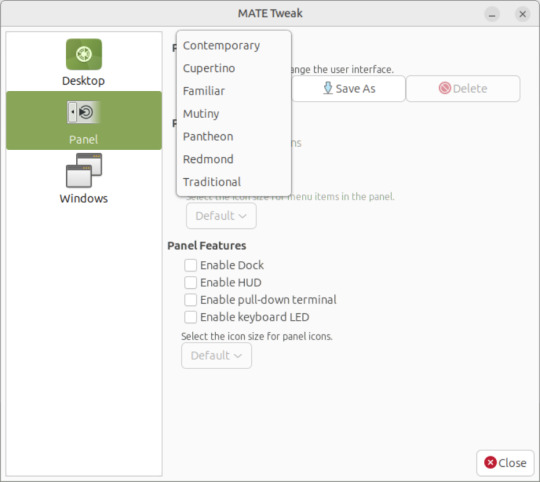
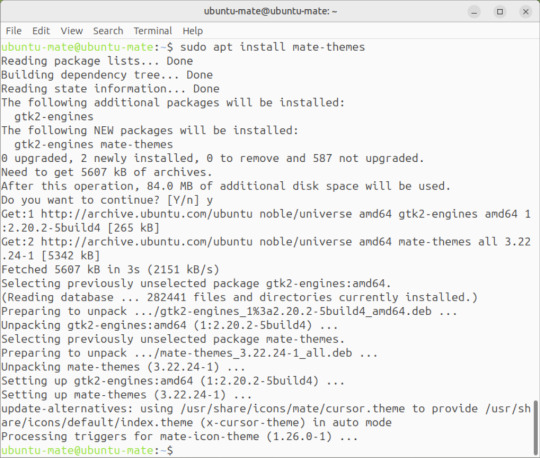


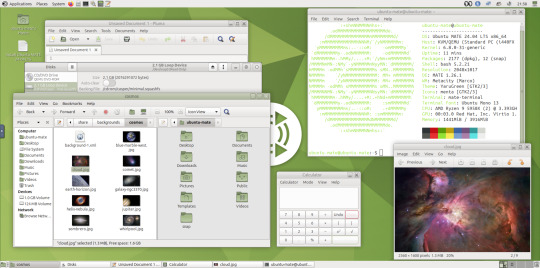





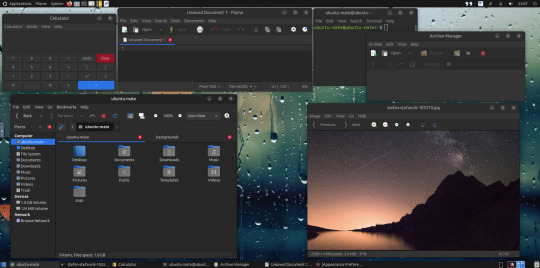



May 2025.
I tried installing a set of themes on Ubuntu MATE 24.04.1 LTS in Distrosea today.
https://distrosea.com/
These themes are provided as a theme package found in vanilla MATE desktops such as Debian and Fedora.
MATE is the modern day continuation of GNOME 2, a very popular, efficient and functional desktop environment from the early 2000s.
The theme pack I selected are compactable GTK3/4 (Graphical Toolkit) versions based on classic GNOME 2 era themes.
Ubuntu MATE website:
https://ubuntu-mate.org/
Debian Linux website:
https://www.debian.org/
Fedora Linux website:
https://fedoraproject.org/spins/mate
See MATE Desktop website here:
https://mate-desktop.org/blog/
About the Graphical Toolkit user interface:
https://en.wikipedia.org/wiki/GTK
I used the MATE Tweak tool to adjust the panels from the 'familiar' layout to the 'traditional' layout. Here are many of the layouts available.
MATE Tweak can change the panel layout between Traditional (GNOME 2), Unity, Redmond (Windows) contemporary (Mac OS) style.
Here are many of the layouts available.
Afterwards, I used the command line to install the themes with the command: sudo apt install mate-themes.
This command then prompted me to agree the system changes and then it installed the required theme files to the list.
I opened up the theme folder in the Caja file manager. This shows all the ones installed on the system.
Next I opened the appearance preferences and cycled through each theme. There are a total of 12 new themes it added alongside the existing Yaru Colour theme collection for Ubuntu.
This package couldn't be installed graphical so this is why I installed it through the terminal. It is also available to install through the Software Manager on Linux Mint.
The theme package can also be installed on the Cinnamon desktop and other linux distributions.
I like these themes as they provide a more 3D feel and is refreshing to see themes for a desktop environment that hasn't moved towards flat design. It themes all the desktop elements from the windows, panels, drop down menus, CSD apps and widgets.
My favourite one is called YaruOK (blue), as it provides resizable window controls, 3D controls and provides a familiar look to the desktop. The theme is also called TraditionalOK.
This theme is a fork of a GTK2 theme called Clear-looks, which was created by Red Hat developers.
YaruOK is a modern variant that uses GTK3 & 4. The theme is rendered in SVG instead of PNG format which improves HiDpi scaling and features themed client side decorations for header bar windows such as the Disks utility.
I also added a GNOME Eyes widget onto the panel!
These fun set of eyes follow your mouse cursor around the screen and can help you find the cursor amongst the clutter of windows. It is built to be very lightweight.
I also like the workspace switcher on the bottom left, which allows you to switch between as many desktop workspaces as you want.
The little square windows within each desktop can be clicked on and moved to another workspace.
Like with other desktop environments, you can also right click a window and move it onto another workspace. Each desktop can be named for a assigned task.
A System Monitor widget can also be added to the panels to display CPU, Memory, Swap and Network processes.
There are many other very interesting widget to play around with on the desktop and panels as well!
Here are the MATE themes in Ubuntu Linux 24.04.1, integrating with the Cinnamon desktop.
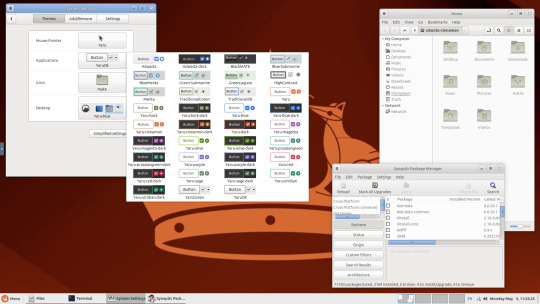
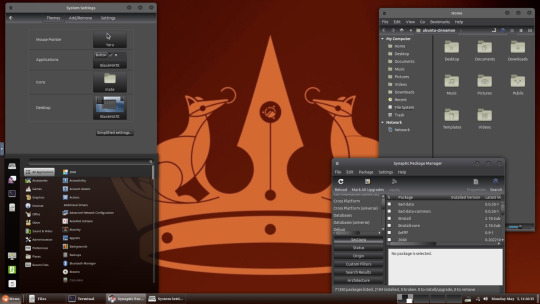
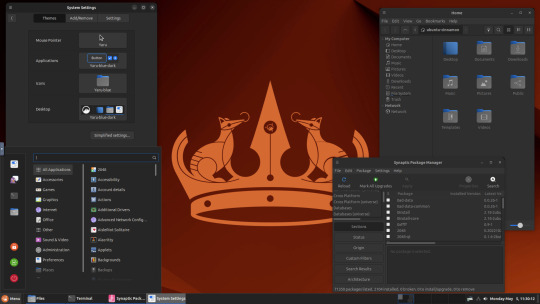

Below are some theming screenshots from Debian MATE 12 Linux.
I've customised the panel, selected the compact menu and changed notification sizes to make it more clearer. The window lists stack onto each other with the increased size.
The MATE panels have adjustable transparency and can be re-coloured and textured very easily through its own preferences box.
See screenshots below!

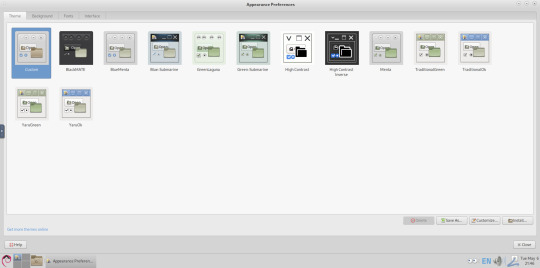

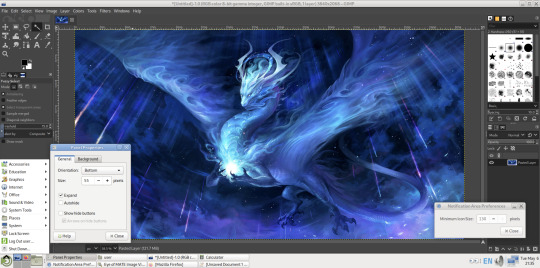
A very interesting look at the user interface elements found in GNOME 2, MATE and Cinnamon Linux desktop environments!
5 notes
·
View notes
Text
Of Gods and Men
Targaryen Harvesters
main list (where the story is)

This is Dune/GOT/HOTD/FAB/ASOIAF crossover AU that you've voted for. If you always wanted to see House Targaryen in space, I got you. Please note how some of the lore of both universes is bent to blend in both worlds. This is my original idea that I've been cooking for at least two years. Be gentle with my work, and enjoy the ride.

The Targaryen Harvester, a marvel of advanced engineering and ancient design, stands as a testament to the ingenuity and technological prowess of House Targaryen. Built to operate in the most inhospitable environments, it is a perfect fusion of cutting-edge technology and the almost mystical properties of drakaon crystals, which form the core of all Targaryen machinery. This harvester is unlike any spice-collecting machine in the known Imperium, combining both efficiency and subtlety in ways that make it a formidable tool on Arrakis.
Exterior Design & Structure
Chassis and Hull: The harvester’s body is sleek and aerodynamic, crafted from composite alloys that blend carbon-based materials with a mysterious Valyrian steel derivative. This combination makes the harvester both lightweight and incredibly durable, capable of withstanding the harsh, abrasive sands and the extreme temperatures of desert worlds like Arrakis.
Stealth Coating: The exterior is coated with a black, matte material that absorbs and disperses radar and infrared signals, giving it a degree of stealth that makes it nearly invisible to most scanning technologies. This also helps the harvester blend seamlessly into the shadowed dunes during night operations.
Compact Size & Modular Design: Unlike the large and cumbersome spice harvesters of the Harkonnens, the Targaryen Harvester is compact, designed for mobility and ease of deployment. Its modular nature allows it to be quickly assembled or disassembled, enabling rapid deployment or withdrawal from the field when needed.
Propulsion & Movement
Hover Technology: The Targaryen Harvester employs an advanced hover propulsion system, powered by drakaon crystals. This system allows it to float just above the surface of the sands, minimizing disturbances and vibrations that might otherwise attract the attention of the sandworms. The hover technology is fine-tuned to maintain stability even in rough terrain, allowing the harvester to glide effortlessly over the undulating dunes.
Adaptive Wings: As part of its hover mechanism, the harvester has retractable wing-like structures that extend from its sides during operation. These wings are not for flight but rather serve as stabilizers that adjust to wind currents and shifting sands, ensuring smooth movement over the desert landscape. When not in use, the wings fold seamlessly into the body of the harvester, maintaining its streamlined shape.
Harvesting Mechanism
Siphoning Arrays: The core feature of the Targaryen Harvester is its siphoning arrays, located within the wing-like extensions. These arrays create a controlled vortex of air that draws in sand and spice, separating the two with a precision unmatched by traditional harvesters. The vortex is generated using ionized air currents created by the drakaon crystal cores, which create a powerful yet gentle pull that sifts through the sands.
Crystal-Based Filtration System: Once the sand and spice are drawn in, the harvester uses a series of crystal-based filters to isolate the precious melange from the surrounding sands. These crystals, sourced from Albiron, possess unique electrostatic properties that attract and bind to the spice particles, allowing the purified spice to be collected while the sand is expelled back onto the ground.
Non-Disruptive Extraction: The process of harvesting is incredibly silent compared to the rumbling, clunky harvesters of the Harkonnens. The low hum emitted by the crystal-powered engines is barely audible even in the stillness of the desert night. This low impact is essential in minimizing vibrations, reducing the risk of attracting shai-hulud, the great sandworms of Arrakis.
Energy Core & Power Source
Drakaon Crystal Core: The heart of the harvester’s power is the drakaon crystal core, a dense, multi-faceted crystal that draws energy from ambient solar radiation and stores it for continuous operation. This core allows the harvester to run for extended periods without needing external fuel sources, making it self-sufficient and capable of long-range operations in remote areas of the desert.
Solar Collectors: In addition to the crystal core, the harvester is equipped with solar collectors that deploy during the day. These collectors absorb solar energy, supplementing the crystal’s power reserve and ensuring that the harvester can operate continuously, even under the harsh sun of Arrakis.
Control Systems & Interfaces
Holographic Interface: The harvester features a holographic interface for its operators, projected from a crystal-based control console within the cockpit. This interface displays real-time data on the harvester’s status, spice yield, and environmental conditions, allowing for precise control of the siphoning process.
Neural Feedback System: Advanced Targaryen technology allows for a neural feedback system that connects the operator’s movements with the harvester’s controls. This creates a near-instantaneous response between the operator’s commands and the vehicle’s actions, enabling delicate maneuvers even in unstable terrain.
Remote Control Capabilities: The harvester can be operated remotely from a command ship or a Targaryen control station, making it possible to manage multiple harvesters simultaneously over a wide area. This remote control system is encrypted and designed to be impervious to conventional Imperial hacking methods.
Defensive Features
Energy Shields: Although primarily a civilian machine, the Targaryen Harvester is equipped with low-level energy shields derived from ancient Valyrian technology. These shields are designed to deflect micrometeor impacts and protect the harvester from smaller projectiles or environmental hazards. While not suitable for full combat, the shields provide an added layer of protection against sabotage.
Electrostatic Discharge Mechanism: To deter potential attacks or interference, the harvester can release a controlled electrostatic discharge through its siphoning arrays, disrupting nearby electronics and creating a localized EMP burst. This can disable smaller drones or tracking devices, allowing the harvester to slip away undetected.
Environmental Adaptability
Climate Adaptation Systems: Designed to function in the extreme climates of desert worlds like Arrakis, the harvester is equipped with systems that regulate internal temperatures and prevent overheating. The materials used in its construction have been treated to withstand corrosive sands and thermal expansion, ensuring long-term durability in harsh conditions.
Low-Friction Hull Design: The harvester’s hull is coated with a low-friction material that prevents sand from accumulating on its surfaces, reducing wear and ensuring that the machine can maintain its optimal performance even during extended operations in sandstorms.
Unique Features
Spice Purification Module: A specialized chamber within the harvester is dedicated to refining the spice it collects. This module uses a process that enhances the purity of the melange, making it more potent and valuable. This capability is part of what makes Targaryen spice so desirable—and so mysterious.
Integrated Holographic Cloaking: For operations that require stealth, the harvester can activate a holographic cloaking field, bending light around it to become nearly invisible against the shifting sands. This feature is rarely used, as it drains the crystal core’s reserves significantly, but it can be invaluable for avoiding detection during sensitive missions.
#hotd x dune crossover#got x dune crossover#asoiaf x dune crossover#dune#crossover#fire and blood#harvester#house targaryen#house of the dragon#asoif/got#a song of ice and fire#game of thrones#dune x reader
12 notes
·
View notes